What about the improper integral? If we want to analyze
| Monday, February 25 | (Lecture #10) |
|---|
Many opportunities for error...
I remarked that there were many opportunities for error. For
example, there are three –'s making up the last minus!
The "area"
What about the improper integral? If we want to analyze ![]() 1
1![]() [ln(x)/x2]dx, then we
will first compute the definite integral
[ln(x)/x2]dx, then we
will first compute the definite integral ![]() 1B[ln(x)/x2]dx, then we will
first compute the definite integral for B "large" and see what happens
when B-->
1B[ln(x)/x2]dx, then we will
first compute the definite integral for B "large" and see what happens
when B-->![]() .
.
![]() 1B[ln(x)/x2]dx=-[ln(x)/x]-1/x|1B=-[ln(B)/B]-1/B-{-[ln(1)/1]-1/1}. Since ln(1)=0, this is (grouping the B terms) 1-[{ln(B)-1}/B].
1B[ln(x)/x2]dx=-[ln(x)/x]-1/x|1B=-[ln(B)/B]-1/B-{-[ln(1)/1]-1/1}. Since ln(1)=0, this is (grouping the B terms) 1-[{ln(B)-1}/B].
The behavior as B-->![]() of
[{ln(B)-1}/B] can be analyzed using L'Hôpital's Rule since both
the top and bottom of the fraction go to
of
[{ln(B)-1}/B] can be analyzed using L'Hôpital's Rule since both
the top and bottom of the fraction go to ![]() as B-->
as B-->![]() . Therefore
limB-->
. Therefore
limB-->![]() [{ln(B)-1}/B]=limB-->
[{ln(B)-1}/B]=limB-->![]() [{1/B}/0]=0.
[{1/B}/0]=0.
We conclude: the improper integral ![]() 1
1![]() [ln(x)/x2]dx converges, and its value is
1. A picture of part of this region was shown
earlier. I don't immediately see a total area of 1 -- these computations
are not at all intuitive!
[ln(x)/x2]dx converges, and its value is
1. A picture of part of this region was shown
earlier. I don't immediately see a total area of 1 -- these computations
are not at all intuitive!
Escape velocity
When I was very young, I read a science fiction novel by Robert
Heinlein which stated "... the escape velocity from the Earth is 7
miles per second ..." and now I would like to sort of verify this
using only well-known (?) facts and some big ideas of physics.
|
|  |
The other type of improper integral
Here we will have a function f defined on a<x<=b (notice that a
is not included!. And our f will have bad behavior as
x-->a+: f(x) will grow and grow and
grow:
limx-->a+f(x)=+![]() . How can we decide if
. How can we decide if ![]() abf(x)dx converges? The outline of the
process we will use resembles the previous kind of improper
integral. We will approximate by
abf(x)dx converges? The outline of the
process we will use resembles the previous kind of improper
integral. We will approximate by ![]() Qbf(x)dx where Q>a, and let
Q-->a+.
Qbf(x)dx where Q>a, and let
Q-->a+.
Toy problem #1
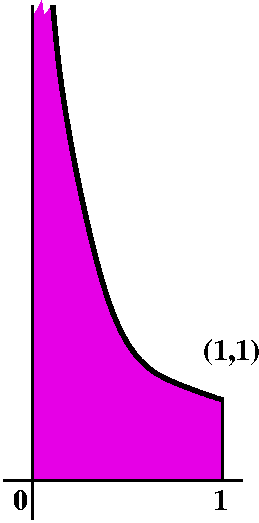 Consider y=1/x on (0,1] (I am leaving out the 0!). Is
Consider y=1/x on (0,1] (I am leaving out the 0!). Is ![]() 01(1/x)dx
finite? First compute
01(1/x)dx
finite? First compute ![]() Q1(1/x)dx. This is ln(x)|Q1=ln(1)-ln(Q). Notice that
ln(Q)-->-
Q1(1/x)dx. This is ln(x)|Q1=ln(1)-ln(Q). Notice that
ln(Q)-->-![]() as
Q-->0+ (you need a picture of y=ln(x) in your head!).
This means that
as
Q-->0+ (you need a picture of y=ln(x) in your head!).
This means that ![]() Q1(1/x)dx-->+
Q1(1/x)dx-->+![]() as Q-->0+. So this
integral diverges. There is no finite amount of area we can assign to
y=1/x between 0 and 1.
as Q-->0+. So this
integral diverges. There is no finite amount of area we can assign to
y=1/x between 0 and 1.
Toy problem #2
Consider y=1/sqrt(x) on (0,1] (I am leaving out the 0!). Is ![]() 01(1/sqrt(x))dx
finite? First compute
01(1/sqrt(x))dx
finite? First compute ![]() Q1(1/sqrt(x))dx. This is 2sqrt(x)|Q1=2sqrt(1)-2sqrt(Q),
Notice that as Q-->0+, 2sqrt(1)-2sqrt(Q)-->2. Therefore
we say that
Q1(1/sqrt(x))dx. This is 2sqrt(x)|Q1=2sqrt(1)-2sqrt(Q),
Notice that as Q-->0+, 2sqrt(1)-2sqrt(Q)-->2. Therefore
we say that ![]() 01(1/sqrt(x))dx converges, and its value is 2.
01(1/sqrt(x))dx converges, and its value is 2.
A note on the picture I only supplied one picture for both of the toy problems. Well, the graphs of both of them have vertical asymptotes at 0, are decreasing, concave up, and go through (1,1). They are qualitatively very much the same. There are only slight cumulative (!) differences in the area, and that's what the preceding algebraic computations show.
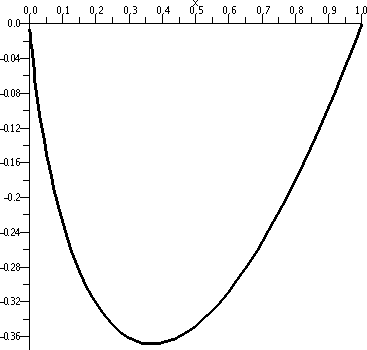 x·ln(x)
x·ln(x)
I asked people for the graph of y=x·ln(x) on the interval
[0,1]. Some people were willing to use their graphing calculators. A
graph much like what is shown to the left was produced.
The graph seems to be a slightly assymetrical bump below the x-axis, hanging from (0,0) and (1,0). The "bottom" is at, about, -1/3 (near x=1/3, actually). If you "ask" your computer or calculator for the value of x·ln(x) at x=0, however, there will be some sort of complaint rather than a number. The machines have been advised that 0 is not in the domain of ln. But the graph certainly seems to indicate that (0,0) is there (wherever there is!). What's going on?
L'H
Really what the graph indicates is a suggested value for
limx-->0+x·ln(x). The guess for this is
0. To verify this guess (in a math course!) we will use
L'Hôpital's Rule. As x-->0+, we have a 0 multiplied by (-)
![]() . L'Hôpital's Rule works on quotients, so we need to rearrange things algebraically. Here we go:
. L'Hôpital's Rule works on quotients, so we need to rearrange things algebraically. Here we go:
limx-->0+x·ln(x)=limx-->0+[ln(x)/{1/x}]=(using L'H)=limx-->0+[{1/x}/{-1/x2}]=limx-->0+-x=0
so the limit is verified.
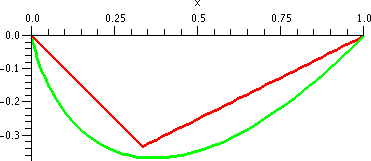 The integral
The integral
How much "area" is included in the bump above? The bump is below the
x-axis so the area should be negative. It sort of resembles a triangle
with base [0,1] and altitude about 1/3. So a guess is that the
area should be about -1/3. An actual graph of the
function and of this approximating
triangle is shown to the right. The function is concave down so
it bulges beneath the triangle. And, in fact, the "point" of the
triangle is below the graph. So there is more (absolute value!) area
in the bump than in the triangle.
Let's compute. The area is ![]() 01x·ln(x)dx. This is officially
an improper integral (it really is difficult to evaluate the integrand
at x=0!). So first I'll compute
01x·ln(x)dx. This is officially
an improper integral (it really is difficult to evaluate the integrand
at x=0!). So first I'll compute ![]() Q1x·ln(x)dx for Q small positive,
and then let Q-->0+. To use FTC we need an
antiderivative of x·ln(x). Integration by Parts again works. If
u=ln(x), then dv=x dx, and du=(1/x)dx and v=(1/2)x2. So:
Q1x·ln(x)dx for Q small positive,
and then let Q-->0+. To use FTC we need an
antiderivative of x·ln(x). Integration by Parts again works. If
u=ln(x), then dv=x dx, and du=(1/x)dx and v=(1/2)x2. So:
![]() x·ln(x)dx=(1/2)x2ln(x)-
x·ln(x)dx=(1/2)x2ln(x)-![]() (1/2)x2(1/x)dx=(1/2)x2ln(x)-(1/4)x2+C
(1/2)x2(1/x)dx=(1/2)x2ln(x)-(1/4)x2+C
The definite integral is
(1/2)x2ln(x)-(1/4)x2|Q1=((1/2)Q2ln(Q)-(1/4)Q2)-((1/2)12ln(1)-(1/4)12).
L'H
I know that limQ-->0+-(1/4)Q2=0 because
Q2 is continuous and I can just "plug in". What about
limQ-->0+(1/2)Q2ln(Q)? Here we (officially!) need
L'Hôpital's Rule again. So:
limQ-->0+(1/2)Q2ln(Q)=limQ-->0+(1/2)[ln(Q)/{1/Q2}=limQ-->0+(1/2)[1/Q}/{-2/Q3}=limQ-->0+(-1/4)Q2=0.
If you now put everything together (and don't lose track of the minus signs!) you can see:
![]() 01x·ln(x)dx converges and its
value is -1/4. The -1/4 is certainly consistent with the estimate we
made earlier, backed up by the red and green graph.
01x·ln(x)dx converges and its
value is -1/4. The -1/4 is certainly consistent with the estimate we
made earlier, backed up by the red and green graph.
A real application ...
This strange function with its somewhat strange graph is actually
related to a function used in applications. The function used in
applications is actually a bit more complicated (sigh). Here is how to
think about it.
| A graph of y=x·ln(x) on [0,1]. The function is concave up and below the x-axis. The area is -1/4, as just computed. |
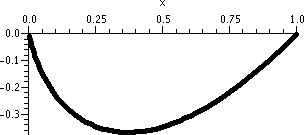 |
| Flip the curve over the x-axis. So this is a graph of y=–x·ln(x) on [0,1]. The function is concave down and above the x-axis. The area is +1/4, because now the region we're considering is above the x-axis. |
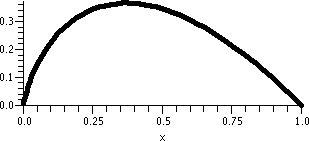
|
| This is a more complicated flip. Replace x by 1-x. This is a flip which exchanges left and right because of the +/- change in the x multiplier. In fact, the left and right are exchanged, and the y-axis and x=1 are interchanged. So this is a graph of y=-(1-x)·ln(1-x) on [0,1]. The function is concave up and above the x-axis. The area is 1/4. |
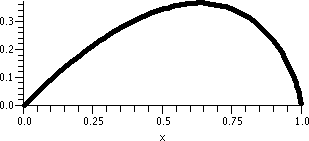
|
| Now add up the two previous functions. Here is a graph of y=–x·ln(x)–(1-x)·ln(1-x) on [0,1]. Yes, it is weird. This function officially has two strange behaviors, at both 0 and 1. The function is called the binary symmetric entropy function and it is used to study the amount of information flowing through a "channel" (you could think of a channel as a wire, and the information as 0's and 1's -- bits). The entropy function helps to analyze what happens in complicated situations where there may be interference (noise). This function has one bump, and its total area is 1/2. |
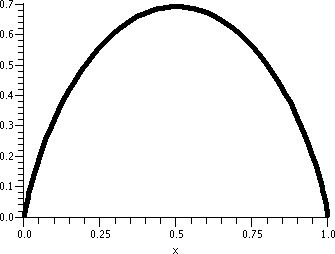
|
Student question
Mr. Lenzo asked whether I could really
predict (?) that the result of adding the two bumps would be just one
symmetric bump. In fact, that result may not occur.
| Here is a graph of x[ln(x)]2 on [0,1]. Because of the square, the function is positive, and the bump is more pronounced. | And this is a graph of x[ln(x)]2+ (1-x)[ln(1-x)]2. So the two bumps suggested by the student comment do show up. It can happen. |
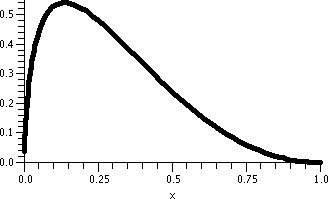 | 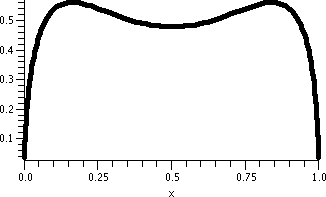 |
The QotD
Does ![]() 01(1/x2)dx converge? If it
does, what is its value?
01(1/x2)dx converge? If it
does, what is its value?
Physics?
The preceding question is quite physical. For example, this might be a
model of an electron moving closer to another electron. Since the
integral diverges this indicates that it would take an infinite
amount of work (using the computations of classical physics!) to move
electrons so they touch.
| Wednesday, February 20 | (Lecture #9) |
|---|
What we did so far ...
I've tried to explain how partial fractions splits up a rational
function into a sum of pieces which are easier to understand and
analyze. In the context of Math 152, the further work is
antidifferentiation. So we've looked at Top(x)/Bottom(x). First we
divided, if necessary, to get the degree of the Top less than the
degree of the Bottom (the quotient is a polynomial which we already
know about). The result, a proper rational fraction, is what we
will investigate now. The Partial Fractions algorithm depends on
factoring Bottom(x). I've tried to show with examples what to do if there are linear factors, like (x-3)2
And now another difficulty ...
Factoring polynomials is more difficult than we have seen so far. In
addition to linear factors, there are polynomials like
x2+1. This polynomial is never zero, so it can't be
written as a product with any linear x-a (if x2+1 were
equal to such a product, when x=a the result would be 0, which is
isn't). So let me show an example.
Yet another example
I'll show you the symbolic pieces, and then solve for them.
11x+7 A Bx+C ----------- = ----- + ------ (x-3)(x2+1) x-3 x2+1So when there is an irreducible quadratic then an unknown linear term needs to be put on top. If we combine terms and look at the tops, the result is
Therefore
11x+7 4 -4x-1 ----------- = ----- + ------ (x-3)(x2+1) x-3 x2+1Integration
11x+7 4 -4x -1 ----------- = ----- + ------ + ----- (x-3)(x2+1) x-3 x2+1 x2+1The first and third terms should not be difficult to recognize and integrate: 4ln(x-3) and -arctan(x). The middle term can be done with w=x2+1 so dw=2x dx, with the result -2ln(w)=-2ln(x2+1). And +C of course. So finally
What is an irreducible quadratic?
An irreducible quadratic is a degree 2 polynomial which has no real
root. So 5x2-9x+17 is an irreducible quadratic but
7x2-88x-20 is not. How do I know this? Well, the roots of
Ax2+Bx+C=0 are given by the famous formula
[(-B+/-sqrt{B2-4AC})/2A]. The roots are real exactly when
the "stuff" under the square root sign in the formula is not
negative. (Negative gives complex roots and I am not supposed to
discuss these with you lest your brains explode.) The
B2-4AC is usually called the discriminant. For
5x2-9x+17 the discriminant is (-9)2-4(5)(17)
sure looks negative and for 7x2-88x-20,
(-88)2-4(-20)7 certainly seems positive.
What happens in general
Powers of linear factors need constants on top. Powers of irreducible
quadratics need degree one "unknowns" on top.
The partial fraction algorithm
| Description | Feasibility |
|---|---|
| Step 0 Long division Take a rational function, and divide Top by Bottom until there is a Quotient (which will be a polynomial) and a remainder. Make the remainder the new top, and then pass that fraction (remainder/Bottom) to the next steps. | This is certainly easy to do by hand or by machine. |
| Step 1 Factoring Factor the bottom into powers of linear polynomials and powers of irreducible quadratics. | If the factorization is known, everything else is easy. This is the part that is authentically computationally difficult. There's a thereom which states that every polynomial can be written as a product of linear factors and irreducible quadratic factors. But actually finding these factors, even approximately, can be a difficult computational task. |
| Step 2 Write a symbolic sum | This is easy to do, once you get used to it. |
| Step 3 Find the values of the
constants Push together the fractions with the symbolic coefficients. Then if this is to be equal to the original rational function, the tops must be equal. Find the values of the symbolic coefficients. | This actually turns out not to be difficult in practice when you learn what you are doing. The equations for the symbolic coefficients are just a collection of linear (first power) equations in the unknowns. It is easy and practical to solve systems of linear equations, even very large systems of linear equations (people deal with systems of thousands of linear equations all the time!). |
If you want to include Step 4, integrating the pieces, then you
should already see that integrating the pieces which come from the
linear factors is not difficult. Integrating the pieces which come
from the irreducatible quadratic factors can certainly be tedious by
hand, but not actually impossible. A complete-the-square step followed
by a trig substitution (x=(constant)tan(![]() ) will do it). It won't be pleasant, but I could imagine doing
low degree examples by hand.
) will do it). It won't be pleasant, but I could imagine doing
low degree examples by hand.
An example, not by hand
The following computation took about half a second on my work
computer, which is several years old and not especially fast. I am a
bit surprised it took that long. (Ahhh ... I experimented further:
just loading the appropriate software seems to take most of the time,
not working on the specific example!) The first command defines the
function, as I wrote it in class. The second command asks to convert
the rational function into its partial fraction form. I can't figure
out the order the pieces are printed -- certainly not any order I can
easily identify. All the pieces one might expect according to the
general statement are there, however. Then the third command asks for
the integral (antiderivative) of this. Take a quick look and see which
pieces you can pick out, just for fun.
>f:=1/(x*(x-2)^3*(3*x-7)^2*(x^2+4)^2*(x^2+2*x+3));
1
f := ----------------------------------------------
3 2 2 2 2
x (x - 2) (3 x - 7) (x + 4) (x + 2 x + 3)
> convert(f,parfrac);
87 1 -54 - 11 x 59049
-------------- - ------- + ---------------- + ------------------
2 18816 x 2 2 2
30976 (x - 2) 924800 (x + 4) 5967850 (3 x - 7)
-11708 - 1727 x 3774530178 1
+ ------------------ - ---------------------- + -------------
2 104750687125 (3 x - 7) 3
314432000 (x + 4) 1408 (x - 2)
-52145 - 44488 x 8229
+ ------------------------- + --------------
2 681472 (x - 2)
8033987874 (x + 2 x + 3)
> int(%,x);
87 -108 x + 88 14003
- ------------- - 1/18816 ln(x) + ----------------- - --------- arctan(x/2)
30976 (x - 2) 2 628864000
14796800 (x + 4)
19683 1727 2 1258176726
- ----------------- - --------- ln(x + 4) - ------------ ln(3 x - 7)
5967850 (3 x - 7) 628864000 104750687125
1 11122 2
- ------------- - ---------- ln(x + 2 x + 3)
2 4016993937
2816 (x - 2)
1/2
7657 1/2 (2 x + 2) 2 8229
- ----------- 2 arctan(--------------) + ------ ln(x - 2)
16067975748 4 681472
Improper integrals: what are they?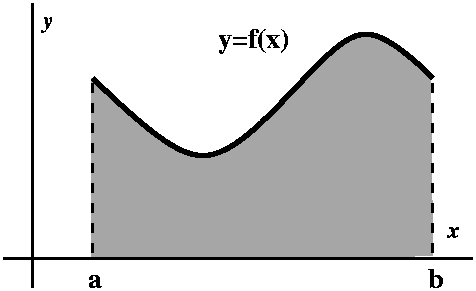 So far we have
discussed computing standard definite integrals. Although certainly a
definite integral like
So far we have
discussed computing standard definite integrals. Although certainly a
definite integral like |
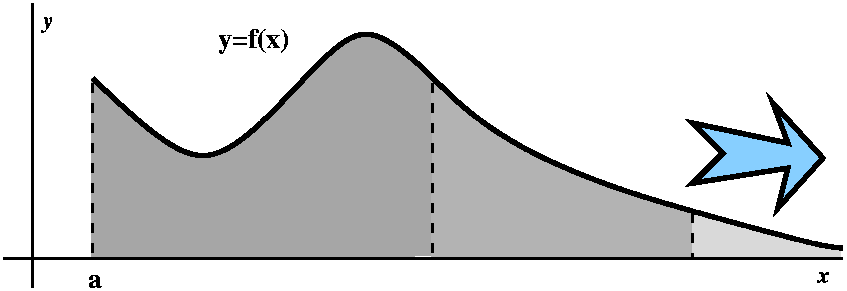 For example, we might consider a situation where, say, b gets larger
and larger and
larger. Where, say, b-->
For example, we might consider a situation where, say, b gets larger
and larger and
larger. Where, say, b-->A completely naive interpretation of the area would declare that since the length of the base is infinite, the total area must somehow be forced to be infinite. More subtle, the height in certain cases will decrease fast enough so that the total integral can be thought of as finite. |
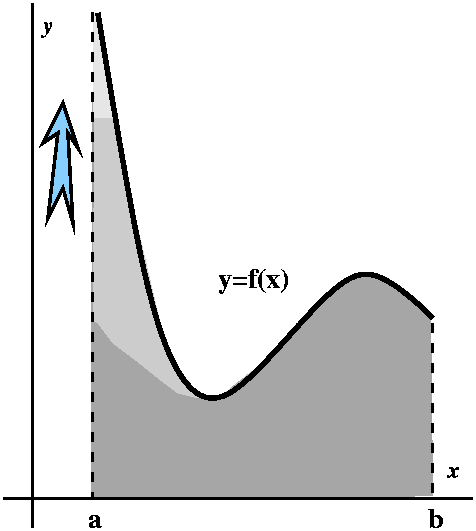 There may also be a sort of defect (?) in the range of f. For
simplicity, consider the situation where, although f is "nice" for
x>b, as x-->+, f(x) gets larger and
largerand larger: in fact, we might need
to try to "integrate" or compute the value of
There may also be a sort of defect (?) in the range of f. For
simplicity, consider the situation where, although f is "nice" for
x>b, as x-->+, f(x) gets larger and
largerand larger: in fact, we might need
to try to "integrate" or compute the value of ![]() abf(x)dx even if
f tends to
abf(x)dx even if
f tends to ![]() as x-->a.
as x-->a.
Again, a first look could convince you that such "areas" need to be
infinite, also, because the height is infinite. But, actually, the way
f grows as x-->a+ is what matters. It is possible to
imagine that the growth of f is so controlled that the total
approximating areas don't tend to infinity. And maybe, in such
situations, we should be able to compute the integral.
I will first consider the "defect in the domain" case.
Toy example #1
Look at y=1/x2. The integral ![]() 1B(1/x2)dx (I'm using B as an
abbreviation for BIG) can be computed directly:
1B(1/x2)dx (I'm using B as an
abbreviation for BIG) can be computed directly:
![]() 1B(1/x2)dx=-1/x|1B=1-(1/B) (be careful of the signs!)
1B(1/x2)dx=-1/x|1B=1-(1/B) (be careful of the signs!)
Now if B-->![]() , certainly
1-(1/B)-->1. Then we will declare that the improper integral
, certainly
1-(1/B)-->1. Then we will declare that the improper integral
![]() 1
1![]() (1/x2)dx converges and its value is 1.
(1/x2)dx converges and its value is 1.
Toy example #2
Look at y=1/x. Consider the analogous integral ![]() 1B(1/x)dx (again think of B as
a BIG number). We compute it:
1B(1/x)dx (again think of B as
a BIG number). We compute it:
![]() 1B(1/x)dx=ln(x)|1B=ln(B)-ln(1)=ln(B)-0
1B(1/x)dx=ln(x)|1B=ln(B)-ln(1)=ln(B)-0
I wanted also to consider here the behavior as B-->![]() , but some students seemed to be
confused (this is confusing!). What does happen to ln(B) when B
gets large? If you only have a loose idea of the graph in your head,
well the log curve might not look like it is increasing too
fast. Well, it actually is not increasing very fast, but it is
increasing. Look: ln(10) is about 2.3, so ln(102)=2ln(10)
is about 4.6 (that's 2·2.3), and ln(103)=3ln(10) is
about 6.9 (that's 3·2.3), etc. Here etc. means I can get values
of ln as large as I want by taking ln's of large enough powers of 10
(hey, ln of 105,000 is bigger than ... 10,000: so
there!). So the values of
, but some students seemed to be
confused (this is confusing!). What does happen to ln(B) when B
gets large? If you only have a loose idea of the graph in your head,
well the log curve might not look like it is increasing too
fast. Well, it actually is not increasing very fast, but it is
increasing. Look: ln(10) is about 2.3, so ln(102)=2ln(10)
is about 4.6 (that's 2·2.3), and ln(103)=3ln(10) is
about 6.9 (that's 3·2.3), etc. Here etc. means I can get values
of ln as large as I want by taking ln's of large enough powers of 10
(hey, ln of 105,000 is bigger than ... 10,000: so
there!). So the values of ![]() 1B(1/x)dx do not approach a specific number as B-->
1B(1/x)dx do not approach a specific number as B-->![]() . Therefore we say:
the improper integral
. Therefore we say:
the improper integral
![]() 1
1![]() (1/x)dx diverges.
(1/x)dx diverges.
The distinction between converges (approaches a specific finite limit) and diverges (does not approach a specific finite limit) is the one that is important in applications and that motivates the distinct use of the two words.
Geometric constrast
I love pictures. I like computation, but I can barely tolerate (!)
"algebra". But I introduced the actual definition of {con|di}vergent
improper integrals with some algebra, and didn't draw any
pictures. Why? Well, because pictures, while useful, don't help too
much. Here are qualitative pictures of the
two graphs.

Well, they are actually different graphs, sorta. But I wanted to emphasize, through sketching them not too carefully (and on different axes, without scales!) these curves both "start at" (1,1), and as they go right, are always positive, decreasing, concave up, with 0 as limits. My eyes, at least, can't tell that one of them (on the left?) has finite total area, and one of them (to the right!) has infinite total area. The difference is quite surprising.
Damped oscillation
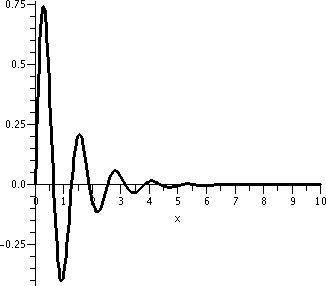 I wanted to investigate the convergence or divergence of
I wanted to investigate the convergence or divergence of ![]() 0
0![]() e-xsin(5x)dx. I chose
this integrand because I wanted you to remember the workshop
problem. Also, it is "real": look at the graph to the right (warning:
the horizontal and vertical scales are very different!). It shows
something that many of you will learn to recognize as damped
oscillation (put a vibrating spring in maple syrup or motor oil or
... well, it will slow down).
e-xsin(5x)dx. I chose
this integrand because I wanted you to remember the workshop
problem. Also, it is "real": look at the graph to the right (warning:
the horizontal and vertical scales are very different!). It shows
something that many of you will learn to recognize as damped
oscillation (put a vibrating spring in maple syrup or motor oil or
... well, it will slow down).
What can we say about ![]() 0
0![]() e-xsin(5x)dx? Well, first let's consider
e-xsin(5x)dx? Well, first let's consider
![]() 0Be-xsin(5x)dx when B is
large. We can compute this using FTC by using Integration by Parts
twice. Here is the result:
0Be-xsin(5x)dx when B is
large. We can compute this using FTC by using Integration by Parts
twice. Here is the result:
![]() 0
0![]() e-xsin(5x)dx=-(5/26)e-xcos(5x)-(1/26)e-xsin(5x)|0B=-(5/26)e-Bcos(5B)-(1/26)e-Bsin(5B)+(1/26).
e-xsin(5x)dx=-(5/26)e-xcos(5x)-(1/26)e-xsin(5x)|0B=-(5/26)e-Bcos(5B)-(1/26)e-Bsin(5B)+(1/26).
Again, the signs may lead to errors, so use some care. Now the B stuff
is the interesting part here. What happens to
-(5/26)e-Bcos(5B)-(1/26)e-Bsin(5B)=[-(5/26)cos(5B)-(1/26)sin(5B)]/eB
as B-->![]() ? Please notice that
the top has some numbers (5/26, 1/26) and values of sine and cosine
which are always between -1 and 1. The bottom has eB which
grows really really fast. So (Squeeze Theorem?) the quotient
will-->0 as B-->
? Please notice that
the top has some numbers (5/26, 1/26) and values of sine and cosine
which are always between -1 and 1. The bottom has eB which
grows really really fast. So (Squeeze Theorem?) the quotient
will-->0 as B-->![]() .
.
We therefore declare that ![]() 0
0![]() e-xsin(5x)dx converges, and its value is
1/26. This certainly isn't obvious.
e-xsin(5x)dx converges, and its value is
1/26. This certainly isn't obvious.
Which is smaller?
Consider 1/x and 1/x2 and e-x. If you think
about it carefully (o.k., if you have to, consider L'Hôpital)
then you should see that as x-->![]() each of these functions approaches 0. 1/x is the
slowest. 1/x2is in the middle, and e-x is the
fastest. Since the 1/x2 integral converges, the smaller
one, with e-x, and with +/- issues (see below) will also
converge.
each of these functions approaches 0. 1/x is the
slowest. 1/x2is in the middle, and e-x is the
fastest. Since the 1/x2 integral converges, the smaller
one, with e-x, and with +/- issues (see below) will also
converge.
The result (what does it mean?)
What does ![]() 0
0![]() e-xsin(5x)dx=1/26
mean? Well, this definite integral is not an area. In the
simplest geometric interpretation, it assigns + to chunks over the
x-axis and - to chunks under the x-axis. So the definite integral is a
weighted sum. I think I could compute the "total" area enclosed by the
curve (algebraically, the integral of the absolute value of the
function) but that would be rather difficult.
e-xsin(5x)dx=1/26
mean? Well, this definite integral is not an area. In the
simplest geometric interpretation, it assigns + to chunks over the
x-axis and - to chunks under the x-axis. So the definite integral is a
weighted sum. I think I could compute the "total" area enclosed by the
curve (algebraically, the integral of the absolute value of the
function) but that would be rather difficult.
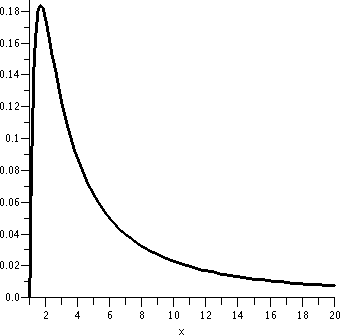
Another example
I wanted to analyze ![]() 1
1![]() [ln(x)/x2]dx. A sort of picture is to the
right. Again, warning: the horizontal and vertical scales are very
different.
[ln(x)/x2]dx. A sort of picture is to the
right. Again, warning: the horizontal and vertical scales are very
different.
QotD
Find ![]() [ln(x)/x2]dx. I
hope that this is done using Integration by Parts.
[ln(x)/x2]dx. I
hope that this is done using Integration by Parts.
| Monday, February 18 | (Lecture #8) |
|---|
First exam
The first exam in this course will be given on Wednesday, February
27. Here is further information.
I want to keep up with the diary, but have had other things to do today (Tuesday, 2/19). I will mostly copy what I did last year, making slight changes. What I did wasn't very different.
Nice representions of functions
Functions can be studied as the (possibly!) interesting objects that
they are, but it is likely that various kinds of functions will be
used by most students in the class to model physical situations, or to
match data sets. Usually people try to use familiar functions first,
and to use formulas for these functions. In the setting of calculus,
we differentiate and integrate functions. Later, in courses following
calculus which many students will take, other things will be done to
functions (Laplace transforms, Fourier transforms, ...). It is
important to get nice representations of functions,
representations which make it easier to do things with the
functions. This is maybe too darn abstract. Let's look at a particular
example.
Polynomials
Polynomials are probably the first functions anyone thinks about. So I
suggest the following polynomial:
((3+(5+8x3)46)37.
Certainly this is a polynomial. It has degree 5,106. I believe
that I can differentiate it with very little difficulty (two uses of
the Chain Rule). How about antidifferentiation? Well, goodness, we
know how to do that ... but we know how to do that easily when this
polynomial is presented nicely, as a sum of constants multiplied by
non-negative integer powers of x. When I typed a request to integrate
something like this into Maple on either
my home or work computers, all I succeeded in doing was freezing the
processors because, I suspect, the program wanted to e-x-p-a-n-d the
presentation and then antidifferentiate. Much storage and processing
was needed to do that. (Don't try this on a Rutgers computer!)
Rational functions
A rational function f(x) is a quotient, P(x)/Q(x), where the top and
bottom are both polynomials. The aim is not to get a nice
representation of such a function. The best-known representation
is called partial fractions. My aim is to describe the method
of changing "small" examples of rational functions into their partial
fraction representation. I'll also comment, as we go through the
steps, about the computational difficulty of doing this representation
in the "real world". It is true that every rational function has a
unique partial fraction representation, just as every polynomial has a
unique standard representation as a sum of multiples of powers of
x. That there is always a partial fraction representation and there is
exactly one such representation is a theorem. The proof takes a while
and is not part of this course. Describing the process and the type of
result to expect is enough.
The textbook presents the partial fraction representation as an integration strategy. It is certainly such a strategy, because once the rational function is written in its partial fraction representation, antidifferentiation is straightforward. So I will discuss antidifferentiating the pieces, also. But there are practical reasons one might want the rational functions decomposed. For example, the repelling force between two classical charged objects (electrons?) is rational (it is inverse square where the variable is the distance between the object). You could imagine that there's a complicated force law which is rational and has singularities (where the bottom of the rational function is 0 and the top is not). I might want to write this as a sum of different forces each with singularities in only one location. That is always possible and is a consequence of the partial fraction representation.
An example
We wrote [(5x-7)/(x2-2x-3)] as a sum of constants
multiplying (x-3)-1 and (x+1)-1 and then got
specific values of the constants. As you'll see this is a typical
partial fractions example. But there's one preparatory step we might
have to do which is not included in this example. What is that?
Suppose I want to look at, say, [(x3+4x-1)/(x2-2x-3)]. My preparation would consist of the following:
x1+2
---------------
x2-2x-3 | x3+0x2+4x-1
x3-2x2-3x
--------------
2x2+7x+1
2x2-4x-6
----------
11x+7So x+2 is the quotient and 11x+7 is the remainder.
We can write the original fraction as:
x3+4x-1 11x+7 ---------- = x+2 + -------- x2-2x-3 x2-2x-3The polynomial is something we know and understand, and it is correctly "packaged" in a standard way. From now on I'll only consider proper rational fractions where the degree of the top is less than the degree of the bottom.
Partial fractions, Step 0
If the input is P(x)/Q(x) and is not proper, then divide the top by
the bottom, and rewrite the result as Quotient+Remainder/Q(x). Here
Quotient will be a polynomial, and Remainder/Q(x) will be a proper
rational fraction. Pass the "Remainder/Q(x)" on to the other steps.
Computational effort of Step 0
This is straightforward, easy to program, and doesn't take much time
or space.
Partial fractions, Step 1, sort of
This step is: given P(x)/Q(x),
find the factors of Q(x). I'll need to say more about this, but look:
6 5 4 3 2
A := 30 x + 179 x - 3859 x - 6591 x + 43369 x + 23500 x - 113652
> factor(A);
(x - 2) (5 x - 11) (x - 9) (2 x + 7) (3 x + 41) (x + 2)
Actually this example is totally silly. I created A by multiplying the
factors which are shown. In reality, factoring is a very
difficult problem.
Most of the protocols which guarantee privacy and security in web transactions rely, ultimately, on the difficulty of factoring, even the difficulty of finding the prime factors of positive integers. The most well-known algorithm (RSA, for Rivest-Shamir-Adelman) is based on the following problem: suppose you know that a positive integer is the product of two primes. What are the primes? Well, 6 is 2 times 3, so ... except that the numbers are hundreds of decimal digits long, and there is no known feasible way of finding the integer factors. In the case of polynomials, the problems are, if anything, even more difficult, as you will see. The types of factors can vary.
Partial fractions, Step 2, sort of
Write a symbolic sum based on the factorization of the bottom. If we wanted to rewrite (11x+7)/(x2-2x-3), which is
(11x+7)/[(x-3)(x+1)], the appropriate symbolic sum is
A B --- + --- x-3 x+1So there is one term for each factor.
Partial fractions, Step 3, sort of
Find values of the constants in the symbolic sum. In this specific
simple (toy!) example, since
A B A(x+1)+B(x-3) --- + --- = -------------- x-3 x+1 (x-3)(x+1)is supposed to be equal to (11x+7)/(x2-2x-3), we know that
Another way of finding A and B so that 11x+7=A(x+1)+B(x-3) is to
"expand" the right-hand side, getting Ax+A+Bx-3B=(A+B)x+(A-3B). Then
we can look at the coefficients of x and the constant term (the
coefficient of x0) to getr
11=A+B
7=A-3B
This is a system of two linear equations in two unknowns and
there are many ways to solve such things. (Hey: A=10 and B=1 are the
solutions of this system!)
Another example
The previous example ended with 11x+7 divided by
x2-2x-3. The bottom (denominator?) here can be factored
easily as (x-3)(x+1). Let me change the example by changing
the bottom. Let's look at [(11x+7)/{(x-3)(x+1)2]. Now
one of the factors has a higher power than 1. Some people say that -1
is a root of the bottom polynomial which has multiplicity 2. In this
case, the symbolic sum has to be modified. There is one term for each
power going up from 1 to the multiplicity. So here:
11x+7 A B C ---------- = --- + --- + ------ (x-3)(x+1)2 x-3 x+1 (x+1)2This is step 2, the symbolic sum. Step 3 requires that specific values be found for A and B and C. What I do here is good for small examples. So I would combine the fractions on the right-hand side, using the least common denominator. You need to be careful about this. I have made mistakes lots of times.
A B C A(x+1)2+B(x-3)(x+1)+C(x-3) --- + --- + ------ = ---------------------------- x-3 x-1 (x-1)2 (x-3)(x+1)2Compare the top of the result here with the top of [(11x+7)/{(x-3)(x+1)2.
The pieces are:
5/2 -5/2 1 --- + ---- + ----- x-3 x+1 (x+1)2Can we integrate the result? Yes. The first piece gives 5/2ln(x-3) and the second piece gives -5/2ln(x+1). The last part is (x+1)-2 which gives (-1)(x+1)-1.
If (x-root)multiplicity is a factor of the bottom, then in Step 2 there will be a bunch of parts, (various constants)/(x-root)integer, with the integer going from 1 to multiplicity. For example, the Step 2 response to the following:
x4-3x2+5x-7 A B C D E F ------------- = ----- + ----- + ----- + ----- + ----- + ----- (x+5)2(x-7)4 x+5 (x+5)2 x-7 (x-7)2 (x-7)3 (x-7)4And this would lead to a system of 6 linear equations in 6 unknowns. By the way, Step 3, solving the linear equations, turns out to be computationally quite straightforward. Here I don't mean doing things by hand, but on a machine. Very big sytems (tens of thousands of linear equations) are solved efficiently on computers frequently.
There is one more significantly different computational difficulty. I will discuss it on Wednesday, the next lecture, and complete the statement of the partial fraction algorithm.
| Wednesday, February 13 | (Lecture #7) |
|---|
Today's tools
This is sort of the tools we had on Monday, with one more equation
whose usefulness will be demonstrated shortly. I will exchange the
previous variable, x, for a new variable, ![]() , which your text prefers here.
, which your text prefers here.
| Derivative formulas | Functional equations |
|---|---|
|
d
d d d | cos(2 sin(2 (sec( (tan( |
A circular area
In the first workshop assignment one of the computations needed was
![]() 01sqrt(1-x2)dx. I truly
expected people to recognize this as a quarter of the unit circle, and
therefore report the value as Pi/4. But if we change the upper limit,
then maybe things aren't as simple. So what is
01sqrt(1-x2)dx. I truly
expected people to recognize this as a quarter of the unit circle, and
therefore report the value as Pi/4. But if we change the upper limit,
then maybe things aren't as simple. So what is ![]() 01/2sqrt(1-x2)dx?
01/2sqrt(1-x2)dx?
If I
want to use FTC to compute this, I should find an antiderivative for
sqrt(1-x2). I tried to motivate the following
substitution: x=sin(![]() ) because
that substitution will make both dx and sqrt(1-x2) come out
"nice". Then dx=cos(
) because
that substitution will make both dx and sqrt(1-x2) come out
"nice". Then dx=cos(![]() )d
)d![]() and
sqrt(1-x2)=sqrt(1-sin(
and
sqrt(1-x2)=sqrt(1-sin(![]() )2)=sqrt(cos(
)2)=sqrt(cos(![]() )2)=cos(
)2)=cos(![]() ). Therefore:
). Therefore:
![]() sqrt(1-x2)dx=
sqrt(1-x2)dx=![]() [cos(
[cos(![]() )]2d
)]2d![]() .
.
We use the double angle formula from the toolbox:
![]() [cos(
[cos(![]() )]2d
)]2d![]() =
=![]() (1/2)[1+cos(2
(1/2)[1+cos(2![]() )]d
)]d![]() =(1/2)[
=(1/2)[![]() +(1/2)sin(2
+(1/2)sin(2![]() )]+C
)]+C
The extra 1/2 comes from the Chain Rule worked backwards on the
"inside" part of cos(2![]() ). Now I'd like to return to x-land by
writing everything in terms of x instead of
). Now I'd like to return to x-land by
writing everything in terms of x instead of ![]() . Since
sin(
. Since
sin(![]() )=x, we know that arcsin(x)=
)=x, we know that arcsin(x)=![]() . That allows us to
translate the first part of the answer back to x's. But what about
sin(2
. That allows us to
translate the first part of the answer back to x's. But what about
sin(2![]() )? Here is where I need the new formula in the toolbox:
sin(2
)? Here is where I need the new formula in the toolbox:
sin(2![]() )=2sin(
)=2sin(![]() )cos(
)cos(![]() ). Each of these I already know in
terms of x's because x=sin(
). Each of these I already know in
terms of x's because x=sin(![]() ) and cos(
) and cos(![]() ) is above (look!): it
is sqrt(1-x2). And we have a formula:
) is above (look!): it
is sqrt(1-x2). And we have a formula:
![]() sqrt(1-x2)dx=(1/2)[arcsin(x)+x sqrt(1-x2)]+C.
sqrt(1-x2)dx=(1/2)[arcsin(x)+x sqrt(1-x2)]+C.
There is cancellation of one of the (1/2)'s with the 2 coming from
sine's double angle formula.
We are not yet done, since we asked for a definite integral.
![]() 01/2sqrt(1-x2)dx=(1/2){arcsin(x)+x sqrt(1-x2)}|01/2.
01/2sqrt(1-x2)dx=(1/2){arcsin(x)+x sqrt(1-x2)}|01/2.
Now arcsin(0)=0 and the other term is also 0 at 0, so the lower limit
gives a contribution of 0. The upper limit has
(1/2){arcsin(1/2)+(1/2)sqrt(1-(1/2)2)}. With some thought
we might recall that arcsin(1/2) is Pi/6, and also "compute" that
sqrt(1-(1/2)2)=sqrt(3)/2. Therefore the definite integral
is
(1/2)(Pi/6)+(1/2)(1/2)(sqrt(3)/2).
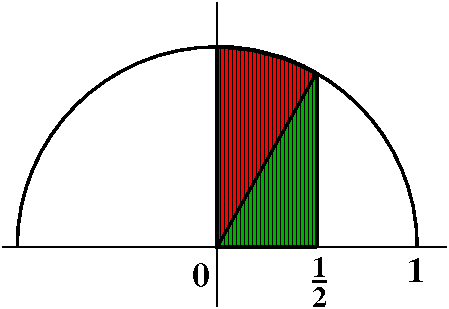
Geometric solution
Actually you can "see" these numbers in the picture.
The triangle has a base whose length is 1/2. Since
the formula for the upper semicircle is y=sqrt(1-x2), the
height of the triangle is sqrt(3)/2. The area of the triangle must
then be (1/2)(1/2)(sqrt(3)/2).
The base acute angle of the triangle is Pi/3, so the
circular sector has inside angle Pi/6. The area of a circular sector
is (1/2)(angle {in radians!)radius2. Since the radius here
is 1, the area of the circular sector is (1/2)(Pi/6).
Maple's version
First the indefinite integral, and then the definite integral.
> int(sqrt(1-x^2),x);
2 1/2
x (1 - x )
------------- + 1/2 arcsin(x)
2
> int(sqrt(1-x^2),x=0..1/2);
1/2
3 Pi
---- + ----
8 12
Another integral (QotD!)
We looked at ![]() [x3/sqrt(1-x2]dx. Again, if x=sin(
[x3/sqrt(1-x2]dx. Again, if x=sin(![]() ) this gets converted into a "power
of trig functions" integral. Actually there was little that was new
about this integral, but I thought it would be cute to assign
finishing the integral as the QotD with students working in pairs. I
am too scared to look at what was handed in. Here is what I hope that
I will read (done by me in green and done by
students in blue. The exercise was yet another
effort to encourage students to work together. Sigh.
) this gets converted into a "power
of trig functions" integral. Actually there was little that was new
about this integral, but I thought it would be cute to assign
finishing the integral as the QotD with students working in pairs. I
am too scared to look at what was handed in. Here is what I hope that
I will read (done by me in green and done by
students in blue. The exercise was yet another
effort to encourage students to work together. Sigh.
If x=sin(![]() ) then dx=cos(
) then dx=cos(![]() )d
)d![]() and sqrt(1-x2)=sqrt(1-
and sqrt(1-x2)=sqrt(1-![]() 2)=cos(
2)=cos(![]() ) and x3=sin(
) and x3=sin(![]() )3 so that the integral
becomes
)3 so that the integral
becomes ![]() sin(
sin(![]() )3d
)3d![]() . In turn we
can "split off" one of the sines, and the result is
. In turn we
can "split off" one of the sines, and the result is ![]() sin(
sin(![]() )2·sin(
)2·sin(![]() )d
)d![]() . This makes us think
of the substitution w=cos((
. This makes us think
of the substitution w=cos((![]() )
with dw=-sin((
)
with dw=-sin((![]() )d(
)d(![]() ). So the integral changes into
). So the integral changes into ![]() (1-w2)–dw
because again sine squared is one minus cosine squared. Now we
{integrate|antidifferentiate} and the result is -w+w3+C (I
pushed through the minus sign) and now back in
(1-w2)–dw
because again sine squared is one minus cosine squared. Now we
{integrate|antidifferentiate} and the result is -w+w3+C (I
pushed through the minus sign) and now back in ![]() -land we get -cos(
-land we get -cos(![]() )+[cos(
)+[cos(![]() )3/3]+C and, finally,
back in x-land (we are not done officially until we are back in
x-land!) we get
-sqrt(1-x2)+[{sqrt(1-x2)}3/3]+C.
)3/3]+C and, finally,
back in x-land (we are not done officially until we are back in
x-land!) we get
-sqrt(1-x2)+[{sqrt(1-x2)}3/3]+C.
Just to complete your joy here is what Maple says, and I don't see the process from the answer:
> int(x^3/sqrt(1-x^2),x);
2
(-1 + x) (x + 1) (2 + x )
-------------------------
2 1/2
3 (1 - x )
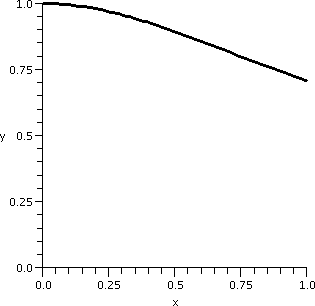
![]() 01sqrt(1+x2)
01sqrt(1+x2)
I want to compute ![]() 011/sqrt(1+x2)dx. The value
of
this integral is the area under y=sqrt(1+x2)dx between 0
and 1. A picture of this area is shown to the right. The curve has
height 1 at x=0, and then decreases to height sqrt(1/2) at x=1. Since
sqrt(1/2) is about .7, I know that the definite integral, always
between (Max. value)·(Interval length) and
(Min. value)·(Interval length), is between 1 and
.7.
011/sqrt(1+x2)dx. The value
of
this integral is the area under y=sqrt(1+x2)dx between 0
and 1. A picture of this area is shown to the right. The curve has
height 1 at x=0, and then decreases to height sqrt(1/2) at x=1. Since
sqrt(1/2) is about .7, I know that the definite integral, always
between (Max. value)·(Interval length) and
(Min. value)·(Interval length), is between 1 and
.7.
It is always nice to know some estimate of things to be
computed. That gives us at least a rough way of checking on the
methods and the result.
How to do it
Look in the toolbox and see
(sec(![]() ))2=(tan(
))2=(tan(![]() ))2+1. If I look at
sqrt(x2+1) then I think of trying x=tan(
))2+1. If I look at
sqrt(x2+1) then I think of trying x=tan(![]() ), so
dx=[sec(
), so
dx=[sec(![]() )]2 and
sec(
)]2 and
sec(![]() )=srqt(x2+1).
Then
)=srqt(x2+1).
Then
![]() 1/sqrt(1+x2)dx becomes
1/sqrt(1+x2)dx becomes
![]() [1/sec(
[1/sec(![]() )][sec(
)][sec(![]() )]2d
)]2d![]() which is
which is
![]() sec(
sec(![]() ) d
) d![]() . We officially know this integral
because of the ludicrous computation done
earlier.
Its value is ln(sec(
. We officially know this integral
because of the ludicrous computation done
earlier.
Its value is ln(sec(![]() )+tan(
)+tan(![]() ))+C. We can
get back to
x-land using what we already know, so the antiderivative we need is
ln(sqrt(x^2+1)+x)+C.
))+C. We can
get back to
x-land using what we already know, so the antiderivative we need is
ln(sqrt(x^2+1)+x)+C.
The definite integral computation then becomes:
ln(sqrt(x^2+1)+x)]01=ln(sqrt(2)+1)+ln(1+0)=ln(sqrt(2)+1)
since ln(1)=0. And ln(sqrt(2)+1) is about .88137, certainly between .7
and 1.
Maple's version
You may ask for an antiderivative. Look at the result, which is
slightly surprising:
> int(1/sqrt(x^2+1),x);
arcsinh(x)
What is this? The function called
"arcsinh" is an inverse function to one of the hyperbolic
functions. The hyperbolic functions are discussed in several sections of
the text. They are frequently just as interesting and relevant to
describing and solving problems as the more commonly used trig
functions. The theory is totally parallel. The trig functions are
connected to the circle, x2+y2=1. The hyperbolic
functions are connected to -x2+y2=1 or
y2=1+x2. There is a Maple instruction which "translates" the
inverse hyperbolic function into things we are supposed to
understand. Here it is:> convert(arcsinh(x),ln);
2 1/2
ln(x + (x + 1) )
The definite integral is recogizable, except for a use of
-ln(A)=ln(1/A) where A=sqrt(2)-1. (You can check that 1/[sqrt(2)-1] is
the same as sqrt(2)+1!) The next instruction finds an approximate
numerical value of the previous answer.>int(1/sqrt(x^2+1),x=0..1);
1/2
-ln(2 - 1)
> evalf(%);
0.8813735879
![]() 01[sqrt(x2-1)/x3]dx
01[sqrt(x2-1)/x3]dx
Because I see sqrt(x2-1) and the toolbox contains the
equation (tan(![]() ))2=(sec(
))2=(sec(![]() ))2-1 I will "guess" at the substitution
x=sec(
))2-1 I will "guess" at the substitution
x=sec(![]() ), which gives
dx=sec(
), which gives
dx=sec(![]() )tan(
)tan(![]() )d
)d![]() and sqrt(x2-1)=tan(
and sqrt(x2-1)=tan(![]() ). With this know, I can rewrite the integral.
). With this know, I can rewrite the integral.
![]() [sqrt(x2-1)/x3]dx becomes
[sqrt(x2-1)/x3]dx becomes ![]() [tan(
[tan(![]() )/sec(
)/sec(![]() )3]sec(
)3]sec(![]() )tan(
)tan(![]() )d
)d![]() .
Then cancel everything you can. The result is
.
Then cancel everything you can. The result is ![]() [cos(
[cos(![]() )]2d
)]2d![]() . We
already considered this integral, The key observation was:
. We
already considered this integral, The key observation was:
(cos(x))2
can be replaced by (1/2)(1+cos(2x)): the degree is halved, but the
function gets more complicated by doubling the frequency.
so
![]() [cos(
[cos(![]() )]2d
)]2d![]() =
=
![]() (1/2)[1+cos(2
(1/2)[1+cos(2![]() )]d
)]d![]() =(1/2)[
=(1/2)[![]() +(1/2)sin(2
+(1/2)sin(2![]() )}+C=(1/2)[
)}+C=(1/2)[![]() +sin(
+sin(![]() )cos(
)cos(![]() )]+C
using the double angle formula for sine, also in today's toolbox.
)]+C
using the double angle formula for sine, also in today's toolbox.
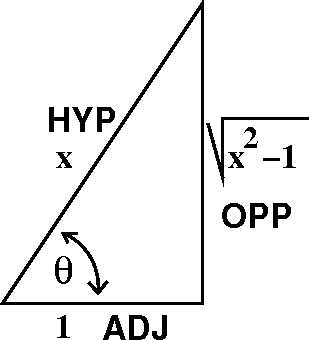 Back to x-land
The translation back turns out to be interesting and more involved
than similar previous transactions. We know that sec(
Back to x-land
The translation back turns out to be interesting and more involved
than similar previous transactions. We know that sec(![]() )=x and we
want to know what sine and cosine of
)=x and we
want to know what sine and cosine of ![]() are in terms of x. One way
some people use is drawing a right triangle with one acute angle equal
to
are in terms of x. One way
some people use is drawing a right triangle with one acute angle equal
to ![]() , and with sides selected
so that sec(
, and with sides selected
so that sec(![]() ) is x. Since
(with
some effort) we know that secant is ADJACENT/HYPOTENUSE, and we can
think that x is x/1, well the triangle must be like what is
pictured. Then Pythagoras allows us to get the oppositite side, as the
square root of the difference of the squares of the hypotenuse and the
adjacent side. From the triangle we can read off
sin(
) is x. Since
(with
some effort) we know that secant is ADJACENT/HYPOTENUSE, and we can
think that x is x/1, well the triangle must be like what is
pictured. Then Pythagoras allows us to get the oppositite side, as the
square root of the difference of the squares of the hypotenuse and the
adjacent side. From the triangle we can read off
sin(![]() )=sqrt(x2-1)/x
and cos(
)=sqrt(x2-1)/x
and cos(![]() )=1/x. Then
(1/2)[
)=1/x. Then
(1/2)[![]() +sin(
+sin(![]() )cos(
)cos(![]() )]+C becomes
(1/2)[arcsec(x)+sqrt(x2-1)/x2]+C. As I explained
in class, arcsec is a fairly loathsome function (yes, this is a
value judgement about a morally neutral function). In fact,
when I asked my silicon friend, the reply was the following:
)]+C becomes
(1/2)[arcsec(x)+sqrt(x2-1)/x2]+C. As I explained
in class, arcsec is a fairly loathsome function (yes, this is a
value judgement about a morally neutral function). In fact,
when I asked my silicon friend, the reply was the following:
>int(sqrt(x^2-1)/x^3,x);
2 3/2 2 1/2
(x - 1) (x - 1) 1
----------- - ----------- - 1/2 arctan(-----------)
2 2 2 1/2
2 x (x - 1)
That is, Maple does not want to deal
with arcsec at all. Yes, if you really wish, there is a
convert instruction to get the arcsec version. With some
effort, you can look at the triangle and see what arcsec is means in
terms of arctan.
Are we stupid?
We're really not done with the problem. I asked for a definite
integral. Here is what happened to that inquiry on a machine:
>int(sqrt(x^2-1)/x^3,x=0..1);
infinity I
I wanted to do this specifically to show you the result. The machine
will do (try to do?) what you ask. This is a sort of silly answer, but
the question is, indeed, sort of ridiculous. The integrand is
[sqrt(x2-1)/x3]. On the interval [0,1], the
bottom has x3. I bet that as x-->0+, something
weird may happen: the integrand gets very, very large. That explains
the infinity in the result. Later in the course we will see how to
assign certain integrals finite values even when bad things happen to
the integrand, but that procedure won't apply in this case. Where does
the I come from? Well, look at x's inside [0,1]. Those x's make
x2-1 negative and the integrand is requesting the
square root of a negative number. Although we are not supposed to
discuss complex numbers in this course, the machine believes we want a
complex number computation, and it emits (?) an I to indicate this.
So a silly question gets an appropriately silly answer.
A final integral with a square root
The last antiderivative of this type I looked at was something like:
![]() sqrt(x2+6x+7)dx.
Here
the novelty is the 4x term. Some algebra which you have likely seen
before can be used to change this to a form we can handle.
sqrt(x2+6x+7)dx.
Here
the novelty is the 4x term. Some algebra which you have likely seen
before can be used to change this to a form we can handle.

Getting rid of the x term
We are "motivated" by the expansion:
(x+A)2=x2+2Ax+A2. We will
complete the square. The picture to the right is supposed to
symbolize this method. Heh, heh, heh ... So:
x2+6x+7=x2+2(3x)+7=x2+2(3x)+32-32+7=(x+3)2-9+7=(x+3)2-2.
Now make the substitution u=x+3 with du=dx. Then
![]() sqrt(x2+6x+7)dx
becomes
sqrt(x2+6x+7)dx
becomes
![]() sqrt(u2-2)dt. We can
sort of handle this with a trig substition but there is -2 instead of
-1.
sqrt(u2-2)dt. We can
sort of handle this with a trig substition but there is -2 instead of
-1.
Start with (tan(![]() ))2=(sec(
))2=(sec(![]() ))2-1 and
multiply by 2 to get
2(tan(
))2-1 and
multiply by 2 to get
2(tan(![]() ))2=2(sec(
))2=2(sec(![]() ))2-2. I "guess" that
I would like to try t=sqrt(2)sec(
))2-2. I "guess" that
I would like to try t=sqrt(2)sec(![]() ). Then
t2=2(sec(
). Then
t2=2(sec(![]() ))2, so t2-2 is
2(tan(
))2, so t2-2 is
2(tan(![]() ))2. Also
dt=sqrt(2)sec(
))2. Also
dt=sqrt(2)sec(![]() )tan(
)tan(![]() ) d
) d![]() . The integral in
. The integral in ![]() -land
is
-land
is ![]() sqrt[2(tan(
sqrt[2(tan(![]() ))2]sqrt(2)sec(
))2]sqrt(2)sec(![]() )tan(
)tan(![]() ) d
) d![]() which is
which is
![]() 2sec(
2sec(![]() )[tan(
)[tan(![]() )]2d
)]2d![]() . As I said in class,
I got bored here. The previous methods can handle this. The details
are complicated and offer lots of opportunity for error. Look below
for a final answer.
. As I said in class,
I got bored here. The previous methods can handle this. The details
are complicated and offer lots of opportunity for error. Look below
for a final answer.
Etc.
> int(sqrt(x^2+6*x+7),x);
2 1/2
(2 x + 6) (x + 6 x + 7) 2 1/2
--------------------------- - ln(x + 3 + (x + 6 x + 7) )
4
I hope you vaguely recognize some of the pieces. For example, the
stuff inside the ln results from ln(sec+tan).
| Monday, February 11 | (Lecture #6) |
|---|
![]() ln(x)dx
ln(x)dx
The volunteers, Ms. Kofman and Mr. Szurick, kindly computed this
straightforward antiderivative. If ![]() udv=uv-
udv=uv-![]() vdu, then
u=ln(x) implies dv=dx so du=(1/x)dx and v=x. Then:
vdu, then
u=ln(x) implies dv=dx so du=(1/x)dx and v=x. Then:
![]() ln(x)dx=x[ln(x)]-
ln(x)dx=x[ln(x)]-![]() x(1/x)dx=x[ln(x)]-
x(1/x)dx=x[ln(x)]-![]() 1dx=x[ln(x)]-x+C.
1dx=x[ln(x)]-x+C.
![]() sin(x)sin(3x)dx
sin(x)sin(3x)dx
Here the vital (!) formulas were obtained by Ms. Javier and Mr. Velez. The lecturer showed his lack of
sophistication by mispronouncing names. So we want to apply
![]() udv=uv-
udv=uv-![]() vdu to
vdu to ![]() sin(x)sin(3x)dx.
This antiderivative is certainly not as simple as the previous one.
sin(x)sin(3x)dx.
This antiderivative is certainly not as simple as the previous one.
I think the volunteers took u=sin(x) and dv=sin(3x)dx. Then
du=cos(x)dx and v=-(1/3)cos(3x). Just the computation of v needs
some care, because there is a sign to worry about and then the factor
(1/3) is needed to "fix up" what happens when the Chain Rule
differentiates cos(3x). So ![]() udv=uv-
udv=uv-![]() vdu becomes:
vdu becomes:
![]() sin(x)sin(3x)dx=-(1/3)sin(x)cos(3x)+
sin(x)sin(3x)dx=-(1/3)sin(x)cos(3x)+![]() (1/3)cos(3x)cos(x)dx
(1/3)cos(3x)cos(x)dx
The plus sign is really two minus signs packaged together. Now things
look bad, because it seems like we have "exchanged" the original
integral for something just as bad. Well, in this case we can try
again. Use integration by parts on ![]() cos(3x)cos(x)dx. (I'll pull out the multiplicative factor 1/3
but remember it later!). Take u=cos(x) and dv=cos(3x)dx. The resulting
du is -sin(x) and the resulting v is (1/3)sin(3x). The signs and the
multipliers are quite important. The integration by parts formula
becomes:
cos(3x)cos(x)dx. (I'll pull out the multiplicative factor 1/3
but remember it later!). Take u=cos(x) and dv=cos(3x)dx. The resulting
du is -sin(x) and the resulting v is (1/3)sin(3x). The signs and the
multipliers are quite important. The integration by parts formula
becomes:
![]() cos(3x)cos(x)dx=(1/3)cos(x)sin(3x)+(1/3)
cos(3x)cos(x)dx=(1/3)cos(x)sin(3x)+(1/3)![]() sin(x)sin(3x)dx.
sin(x)sin(3x)dx.
We get the original integral back. This plus sign is also two minus
signs. All of the constants are important. Suppose we plug this into
our first Integration by Parts:
![]() sin(x)sin(3x)dx=-(1/3)sin(x)cos(3x)+(1/3)((1/3)cos(x)sin(3x)+(1/3)
sin(x)sin(3x)dx=-(1/3)sin(x)cos(3x)+(1/3)((1/3)cos(x)sin(3x)+(1/3)![]() sin(x)sin(3x)dx)
sin(x)sin(3x)dx)
Let's call JV the antiderivative we want. Then the equation above is:
JV=-(1/3)sin(x)cos(3x)+(1/3)((1/3)cos(x)sin(3x)+(1/3) JV)
so we can solve for JV.
JV=-(1/3)sin(x)cos(3x)+(1/3)((1/3)cos(x)sin(3x)+(1/3) JV) is
JV=-(1/3)sin(x)cos(3x)+(1/9)cos(x)sin(3x)+(1/9)JV so
(1-{1/9})JV=-(1/3)sin(x)cos(3x)+(1/9)cos(x)sin(3x) and since 1-{1/9} is 8/9, we can divide by 8/9 to get
JV=(9/8)(
-(1/3)sin(x)cos(3x)+(1/9)cos(x)sin(3x))
It is not at all clear to me that
![]() sin(x)sin(3x)dx=(9/8)( -(1/3)sin(x)cos(3x)+(1/9)cos(x)sin(3x))+C
sin(x)sin(3x)dx=(9/8)( -(1/3)sin(x)cos(3x)+(1/9)cos(x)sin(3x))+C
Comment I just did this antiderivative with
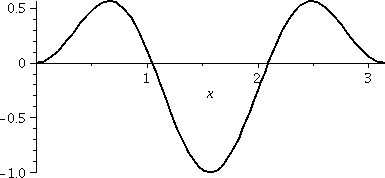 A definite integral
A definite integral
Please notice that sin(x) and sin(3x) are both 0 when x=0 and x=Pi
(sines are always 0 at integer multiples of Pi). This means (and this
is almost clear, if you assume the antiderivative result above is
correct!) ![]() 0Pisin(x)sin(3x)dx=0. A picture of
sin(x)sin(3x) on the interval [0,Pi] is shown to the right (a kind
stranger helped me with this in class -- I would thank him here if I
knew his name!). Notice that, even with the picture, it is not totally
clear to me that the positive areas (above the x-axis) exactly
balance out the negative area below the axis. They do, though. It
turns out that integrals of this type come up very often when
looking at vibrations of things, and that this integral is 0 (and
other similar integrals, also) is quite useful. (I then mentioned
hairs in the cochlea, which is a structure inside the ear: too much
digression. Apologies!).
0Pisin(x)sin(3x)dx=0. A picture of
sin(x)sin(3x) on the interval [0,Pi] is shown to the right (a kind
stranger helped me with this in class -- I would thank him here if I
knew his name!). Notice that, even with the picture, it is not totally
clear to me that the positive areas (above the x-axis) exactly
balance out the negative area below the axis. They do, though. It
turns out that integrals of this type come up very often when
looking at vibrations of things, and that this integral is 0 (and
other similar integrals, also) is quite useful. (I then mentioned
hairs in the cochlea, which is a structure inside the ear: too much
digression. Apologies!).
![]() sin(sqrt(x))dx
sin(sqrt(x))dx
The final example in lecture was done by Ms. Gautam and Mr. Lee. The antiderivate of sin(sqrt(x)) (this
is a composition, not a multiplication!) is quite
irritating. Probably the best way to begin it is with a
substitution. Try w=sqrt(x), so dw=(1/2)[1/sqrt(x)]dx. Let's solve for
dx: dx=2sqrt(x)dw=2w dw. Then the integral is changed:
![]() sin(sqrt(x))dx=2
sin(sqrt(x))dx=2![]() w·sin(w)dw
w·sin(w)dw
Here I have pulled out the multiplicative factor 2, and changed the
sqrt(x) inside the sine to w. Whew! If you don't do this initial
substitution, then ... well, we have. Let me show you what happens now
(I will forget the 2 for now) to 2![]() w·sin(w)dw. We will use
w·sin(w)dw. We will use ![]() udv=uv-
udv=uv-![]() vdu with u=w
and dv=sin(w) so that du=dw and v=-cos(w). The result is not hard to
finish up:
vdu with u=w
and dv=sin(w) so that du=dw and v=-cos(w). The result is not hard to
finish up:
![]() w·sin(x)dw=-w·cos(w)+
w·sin(x)dw=-w·cos(w)+![]() cos(w)dw=-w·cos(w)+sin(w)+C.
cos(w)dw=-w·cos(w)+sin(w)+C.
We can substitute back and remember the 2 so that
![]() sin(sqrt(x))dx=-2sqrt(x)·cos(sqrt(x))+2sin(sqrt(x))+C
sin(sqrt(x))dx=-2sqrt(x)·cos(sqrt(x))+2sin(sqrt(x))+C
and I just mention again that there are lots of signs and constants
which are sources of error.
Integer powers of trig functions
The goal today is to show you some algebraic tricks which can be used to compute (in principal!) the
antiderivative of any integer powers of trig functions. I sincerely
hope that you won't have to use these tricks too often once you're out
of Math 152, and that you will have "machinery" available to compute
these integrals. But, as you will see, even with machinery, you will
need to cope with the results, and sometimes they can be irritating to
understand and use.
| Sine & Cosine Tools |
d
| 1=(cos(x))2+(sin(x))2 |
|---|---|---|
| d
| cos(2x)=(cos(x))2-(sin(x))2 |
![]() sin(x)3cos(x)3dx
sin(x)3cos(x)3dx
This is (relatively) easy, as you will see. What we can do is "borrow"
a cosine, say. What do I mean? Well:
![]() (sin(x)3cos(x)3dx=
(sin(x)3cos(x)3dx=![]() sin(x)3cos(x)2[cos(x)]dx
sin(x)3cos(x)2[cos(x)]dx
Maybe this suggests the substitution w=sin(x). Then dw=cos(x)dx and we
can write sin(x)3 as w3. What about the last
chunk of the integrand (the function we're integrating)? Well, that's cos(x)2, and since cos(x)2=1-sin(x)2, we see that cos(x)2=1-w2. Now:
![]() sin(x)3cos(x)2[cos(x)]dx=
sin(x)3cos(x)2[cos(x)]dx=![]() w3[1-w2]dw=
w3[1-w2]dw=![]() w3-w5dw=(1/4)w4-(1/6)w6+C
w3-w5dw=(1/4)w4-(1/6)w6+C
If we return from w-land to x-land, the answer turns out to be
(1/4)sin(x)4-(1/6)sin(x)6+C.
And another way
An inquisitive person might notice the following: we could have
borrowed a sine. Here:
![]() (sin(x)3cos(x)3dx=
(sin(x)3cos(x)3dx=![]() sin(x)2cos(x)3[sin(x)]dx
sin(x)2cos(x)3[sin(x)]dx
and take w=cos(x), so dw=-sin(x)dx and -dw=sin(x)dx. Now it is sin(x)2 which we should think of as 1-cos(x)2=1-w2 and replace cos(x)3 by w3, so that:
![]() sin(x)2cos(x)3[sin(x)]dx=–
sin(x)2cos(x)3[sin(x)]dx=–![]() [1-w2]w3dw=
[1-w2]w3dw=![]() w5-w3dw=(1/6)w6-(1/4)w4+C
w5-w3dw=(1/6)w6-(1/4)w4+C
Things may get a bit tricky. I pulled out a minus first, and then
reinserted it when I multiplied the powers of w inside the
integral. Then I antidifferentiated. So the answer is (substituting
back cos(x) for w here)
(1/6)cos(x)6-(1/4)cos(x)4+C
What's going on?
Let's see: we seem to have two
answers for ![]() sin(x)3cos(x)3dx. They are
sin(x)3cos(x)3dx. They are
(1/4)sin(x)4-(1/6)sin(x)6+C
and
(1/6)cos(x)6-(1/4)cos(x)4+C.
If you love (?) trig functions, you know that there are many more trig
identities besides the basic ones listed above in the Sine & Cosine Tools. Maybe the functions
(1/4)sin(x)4-(1/6)sin(x)6 and
(1/6)cos(x)6-(1/4)cos(x)4 are
actually the same.
Plug in x=0. Then (1/4)sin(x)4-(1/6)sin(x)6
becomes 0 (hey: sin(0)=0) and
(1/6)cos(x)6-(1/4)cos(x)4 becomes 1/6-1/4
because cos(0)=1. And 1/6-1/4 is not 0. What is going on here?
Let me in fact make things more difficult before explaining more.
And Maple's answer ...
Let's see what we get:
> int(sin(x)^3*cos(x)^3,x);
2 4 4
-1/6 sin(x) cos(x) - 1/12 cos(x)
This seems to be different from both of the previous answers. Actually
things aren't that bad because if you substitute 1-cos(x)2
for the sin(x)2 the answer becomes the cosine answer, but
Maple chooses to write the answer this
way. I still haven't answered: What is going on here?
![]() x(x+1)dx
x(x+1)dx
So let me try to integrate something really really simple and get two
"different" answers. It will be an artificial example. How can we find
an antiderivative of x(x+1)? Well, a sane human being would multiply
and get x2+x and then integrate to get
(1/3)x3+(1/2)x2 (+C). A crazy person (or a
computer trying to follow a badly implemented algorithm) could do
the following: integrate by parts. So:
I chose to integrate by parts with fairly silly parts. It is all legal: silly but legal. Certainly one antiderivative of (x+1) is (1/2)(x+1)2 and then a valid antiderivative of that is (1/6)(x+1)3 (check them both by differentiating!).x (x+1)dx=(1/2)x(x+1)2-
(1/2)(x+1)2dx=(1/2)x(x+1)2-(1/6)(x+1)3. udv = uv - vdu u=x du=dx dv=(x+1)dx v=(1/2)(x+1)2
Therefore (1/3)x3+(1/2)x2 and
(1/2)x(x+1)2-(1/6)(x+1)3 must both be
antiderivatives of x(x+1). Please notice that the first answer has
value 0 when x=0 and the second answer has value -1/6 when x=0, so
these are distinct functions! Is there a problem? Actually, no. Here
theory (if you remember MVT) says you can have infinitely many (not
just 2!) distinct antiderivatives of one function, provided they
differ by a constant. And, indeed, algebra shows exactly this:
(1/2)x(x+1)2-(1/6)(x+1)3=
(1/2)x(x2+2x+1)-(1/6)(x3+3x2+3x+1)=
(1/2)x3+x2+(1/2)x-(1/6)x3-(1/2)x2-(1/2)x-(1/6)=
(1/3)x3-(1/2)x2-(1/6)
|
Huh? (and a picture) The two graphs are parallel to each other. To the right is a graph of both (1/3)x3+(1/2)x2 and (1/2)x(x+1)2-(1/6)(x+1)3. Of course this example is maybe quite silly, but if you use computer algebra systems, you've always got to remember that "different" answers can both be valid! A computer program can't always be relied on to give sensible (?) answers. | 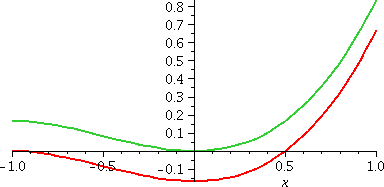 |
|
Back to explaining To the right is a graph of the two different antiderivatives of sin(x)3cos(x)3 on the interval [0,2Pi]. I think that (1/4)sin(x)4-(1/6)sin(x)6 is in green and (1/6)cos(x)6-(1/4)cos(x)4 is in red and if you believe in pictures, you can see that these curves are parallel also: they differ by a constant. So you and a friend who algebraically work on antiderivatives of functions may well come up with superficially different answers, and both of them may be correct! This is weird and wonderful. | 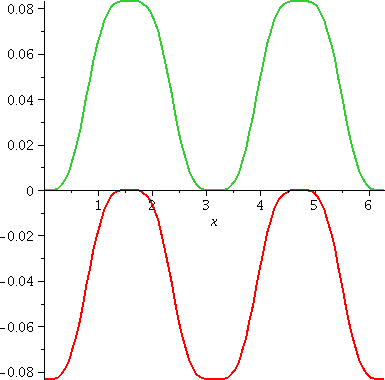
|
![]() sin(x)3cos(x)2dx
sin(x)3cos(x)2dx
This is easy. "Borrow" a sine, convert everything into cosines using a
formula, etc. Things are easy when there is at least one odd
power. But:
![]() sin(x)2cos(x)2dx
sin(x)2cos(x)2dx
Now everything is different. If I borrow, what remains can't be
written very nicely in terms of the candidate substitution. A
different trick is used. It converts squares of sines and cosines to
first powers but it doubles the frequency. Here is what I mean:
Look at the tools. We have
1=(cos(x))2+(sin(x))2
cos(2x)=(cos(x))2-(sin(x))2
Add the equations and divide by 2. The result is (1/2)[1+cos(2x)]=cos(x)2.
Subtract the equations and divide by 2. The result is (1/2)[1-cos(2x)]=sin(x)2.
Let's use these equations in ![]() sin(x)2cos(x)2dx. So we get
sin(x)2cos(x)2dx. So we get ![]() (1/2)[1-cos(2x)](1/2)[1+cos(2x)]dx. We
started out with degree 2+2 and now we have degree 1+1, but the
argument in the cosine is 2x, not x. Next, multiply:
(1/2)[1-cos(2x)](1/2)[1+cos(2x)]dx. We
started out with degree 2+2 and now we have degree 1+1, but the
argument in the cosine is 2x, not x. Next, multiply:
![]() (1/2)[1-cos(2x)](1/2)[1+cos(2x)]dx=
(1/4)
(1/2)[1-cos(2x)](1/2)[1+cos(2x)]dx=
(1/4)![]() 1-cos(2x)2dx
1-cos(2x)2dx
and I pulled out the two 1/2 multiplicative factors to get the
1/4. But now we have cos(2x)2 and what shall we do? A burst
of genius (not really, but there is some inspiration!) turns
(1/2)[1+cos(2x)]=cos(x)2 into
(1/2)[1+cos(4x)]=cos(2x)2. (Halve the exponent and double
the frequency!) So:
(1/4)![]() 1-cos(2x)2dx=
(1/4)
1-cos(2x)2dx=
(1/4)![]() 1-(1/2)[1+cos(4x)]dx.
1-(1/2)[1+cos(4x)]dx.
I can "do" each of the pieces (although I got the constants confused in class!). The answer is
(1/4)(x-(1/2)[x+(1/4)sin(4x)])+C.
Incidentally, Maple's answer is the same as this one, except (sigh) it is written differently:
3
-1/4 sin(x) cos(x) + 1/8 sin(x) cos(x) + x/8
I know it is the same since both answers have value 0 when x=0. The
"constant" that separates them is therefore 0.
Reduction formula
Here is probably what Maple uses on powers of sine.
Since
![]() (sin(x))ndx=
(sin(x))ndx=
![]() (sin(x))n-1 sin(x)dx we can do this:
(sin(x))n-1 sin(x)dx we can do this:
But the integral you get "out" is (sin(x))n-1{-sin(x)}-(n-1)(sin(x))n-1 sin(x)dx=(sin(x))n-1{-cos(x)}-(n-1)
(-cos(x))(sin(x))n-2cos(x)dx udv = uv - vdu u=(sin(x))n-1 du=(n-1)(sin(x))n-2cos(x)dx dv=sin(x)dx v=-cos(x)
> int(sin(x)^9,x);
8 6 16 4
-1/9 sin(x) cos(x) - 8/63 sin(x) cos(x) - --- sin(x) cos(x)
105
64 2 128
- --- sin(x) cos(x) - --- cos(x)
315 315
Now secants and tangents
I want to describe how to find ![]() (sec(x))A(tan(x))Bdx if A and B are
non-negative integers. So I will concentrate of how to do this by
hand. You need to know this for exams in Math 152. Again, if I were
describing a method to be implemented by a program, I'd say other
things. Here I will definitely only look at
small A and B because things get very messy rapidly.
(sec(x))A(tan(x))Bdx if A and B are
non-negative integers. So I will concentrate of how to do this by
hand. You need to know this for exams in Math 152. Again, if I were
describing a method to be implemented by a program, I'd say other
things. Here I will definitely only look at
small A and B because things get very messy rapidly.
What's needed for these functions
| Secant & Tangent Tools |
d
|
(sec(x))2=(tan(x))2+1 |
|---|---|---|
| d
|
(tan(x))2=(sec(x))2-1 |
Early examples
![]() (sec(x))2dx=tan(x)+C
(sec(x))2dx=tan(x)+C
![]() (tan(x))2=
(tan(x))2=![]() (sec(x))2-1 dx
=tan(x)-x+C
(sec(x))2-1 dx
=tan(x)-x+C
I hope that you see even these "low degree" examples have a bit of novelty. Even worse are the first powers!
![]() tan(x) dx=
tan(x) dx=![]() [sin(x)/cos(x)]dx=
[sin(x)/cos(x)]dx=![]() -(1/u)du=-ln(u)+C=-ln(cos(x))+C=ln(sec(x))+C
-(1/u)du=-ln(u)+C=-ln(cos(x))+C=ln(sec(x))+C
where I rewrote tan(x) as sin(x) over cos(x), and then used the
substitution u=cos(x) with du=-sin(x) dx and then got a log and
then pushed the minus sign inside the log by taking the reciprocal of
the log's contents! Horrible.
Much worse, much much
worse, is the following:
This "computation" is probably the single most irritating (because of the lack of motivation) in the whole darn course. The history (I don't have a convenient reference) of this fact is that it was discovered as a result of the construction of certain numerical tables used for ocean navigation. This fact is sort of absurd.
QotD
What is ![]() sin(x)3cos(x)2dx?
sin(x)3cos(x)2dx?
Hey, isn't this an antiderivative which was called "easy" earlier? Huh. Nasty, nasty, nasty lecturer.
| Wednesday, February 6 | (Lecture #5) |
|---|
Now we'll begin a major part of the course dealing with the symbolic (not numerical) computation of antiderivatives. The word "antiderivative" is long, and so I'll use the shorter word "integral".
There are two major methods:
Meeting integration by parts
The derivative of u(x)v(x) is u´(x)v(x)+u(x)v´(x). So this
has to be also an integration formula. Let's see:
![]() (u´(x)v(x)+u(x)v´(x))dx=u(x)v(x)
(u´(x)v(x)+u(x)v´(x))dx=u(x)v(x)
but even that looks a little bit silly. The left-hand side is
also
![]() u´(x)v(x)dx+
u´(x)v(x)dx+![]() u(x)v´(x)dx. That doesn't seem neat. But here is another
way of writing the same equation:
u(x)v´(x)dx. That doesn't seem neat. But here is another
way of writing the same equation:
![]() u(x)v´(x)dx=u(x)v(x)-
u(x)v´(x)dx=u(x)v(x)-![]() u´(x)v(x)dx
u´(x)v(x)dx
where we took one of the integrals and put it "on the other
side". This is the formula for Integration by
Parts. The u and v letters are used by almost everyone. There
is also some standard abbreviation which most people use. It's this:
v´(x) is dv/dx, so v´(x)dx=dv. And du=u´(x)dx. Then the
formula becomes more compact and easier to remember:
![]() udv=uv-
udv=uv-![]() vdu
vdu
which is very telegraphic. The remainder of the lecture is a sequence
of examples.
Example #0
![]() exdx=ex+C. Well, that's not too
illuminating. Let me try something a bit more complicated.
exdx=ex+C. Well, that's not too
illuminating. Let me try something a bit more complicated.
Example #1
How about ![]() xexdx. Notice, please, that integration is NOT
multiplicative. While the integral of x is (1/2)x2 (yeah,
yeah, +C), the integral of x2=x·x, is
not {(1/2)x2}·{(1/2)x2} (the degree is wrong, the constant is wrong, and the idea
is wrong!). So we need a new trick, and this new trick is
Integration by Parts. I tend to think of Integration by Parts whenever
I see a product of functions that somehow seem unrelated to each
other, "like" x and ex. Your intuition will develop as you
do more and more examples.
xexdx. Notice, please, that integration is NOT
multiplicative. While the integral of x is (1/2)x2 (yeah,
yeah, +C), the integral of x2=x·x, is
not {(1/2)x2}·{(1/2)x2} (the degree is wrong, the constant is wrong, and the idea
is wrong!). So we need a new trick, and this new trick is
Integration by Parts. I tend to think of Integration by Parts whenever
I see a product of functions that somehow seem unrelated to each
other, "like" x and ex. Your intuition will develop as you
do more and more examples.
Here I will take u=x and dv=exdx. I will need du, which is
dx, and v, which is ex. I can do the derivative and the
integral "on the fly" -- this is the first real example. Then
![]() udv=uv-
udv=uv-![]() vdu becomes
vdu becomes
![]() xexdx=xex-
xexdx=xex-![]() exdx=(easy to
finish!)xex-ex+C.
exdx=(easy to
finish!)xex-ex+C.
Comments
Before jumping forward to other examples, let me analyze this
"easiest" example first.
Comment A Is the result correct? Well, the method says that
xex-ex+C is an antiderivative of
xex. Should we believe this, or, better, is there a way of
checking the result. Well, certainly: differentiation is almost always
easier than integration (antidifferentiation). So let us d/dx the
result:
d/dx(xex-ex+C)=d/dx(xex)-d/dx(ex)+d/dx(C)=(ex+xex)-ex+0=xex.
This shouldn't be so amazing, after all, since integration by parts
and the product rule are inverses of each other. Integration by parts
just arranges things well.
Comment B This is a relatively easy example. There aren't many
possibilities for the "parts". Certainly there will be more choices in
other cases.
Comment C This is my feeling about Intgration by Parts: I have
udv, and then I trade it in for vdu, "paying" a penalty of uv. The
idea is that the uv cost allows you to change the function you need to
integrate. As soon as you select, say, u, you then have dv, and you
can sometimes look forward and "see" vdu. You will be successful if
that is somehow simpler or easier than the starting integral. Machines
are fairly good at this, but, honestly, experienced human beings are
even better!
Example #2
Let's do ![]() x2exdx. (I am trying to build a
hierarchy of examples, moving from easy to more difficult.) Here try
(although there are other choices!) u=x2 and
dv=ex. Then we need du=2xdx and v=ex. I
mentioned in class and I want to restate here: even when I am alone,
and don't need to teach, I tend to write out all of the
details, including explicit descriptions of u and dv and du and v and
then the Integration by Parts formula. I have found that if I am lazy
and don't do this, then disaster (errors!) occur far too often, and I
just spend more time, because I need to do the computation again and
again. So
x2exdx. (I am trying to build a
hierarchy of examples, moving from easy to more difficult.) Here try
(although there are other choices!) u=x2 and
dv=ex. Then we need du=2xdx and v=ex. I
mentioned in class and I want to restate here: even when I am alone,
and don't need to teach, I tend to write out all of the
details, including explicit descriptions of u and dv and du and v and
then the Integration by Parts formula. I have found that if I am lazy
and don't do this, then disaster (errors!) occur far too often, and I
just spend more time, because I need to do the computation again and
again. So ![]() udv=uv-
udv=uv-![]() vdu becomes
vdu becomes
![]() x2exdx=x2ex-
x2exdx=x2ex-![]() 2xexdx.
2xexdx.
What about
![]() 2xexdx? We can pull out the multiplicative
constant 2 and just get
2
2xexdx? We can pull out the multiplicative
constant 2 and just get
2![]() xexdx. But we know what that integral is -- we just
computed it! Therefore
xexdx. But we know what that integral is -- we just
computed it! Therefore
![]() x2exdx=x2ex-
x2exdx=x2ex-![]() 2xexdx=x2ex&ndash(xex-ex+C)
2xexdx=x2ex&ndash(xex-ex+C)
The final result would usually be written
x2ex-xex+ex+C
and I should make several comments about this. First, notice that even
in this still relatively simple computation several minus signs
occur. There will be a plethora of minus signs as we use integration
by parts. The word plethora is a great SAT vocabulary work, and
one meaning is "A superabundance; an excess". The minus signs are very
easy to get confused about. A second thing is the apparent silliness
of –(+C) becoming just "+C". Everyone does that. This
just means an additive constant, and its specific name doesn't matter.
I think 3C and -5C etc. will all get renamed +C during this semester
during antidifferentiation exercises.
Example #3
Let's do ![]() x3exdx. As I began to address this
problem, I was aware of some unrest in class. So I abandoned the
problem entirely, and decide instead to do
x3exdx. As I began to address this
problem, I was aware of some unrest in class. So I abandoned the
problem entirely, and decide instead to do
Example #n
Suppose n is a positive integer.
What can we say about ![]() xnexdx? Well, if u=xn and
v=exdx, then du=nxn-1dx and v=ex. And
xnexdx? Well, if u=xn and
v=exdx, then du=nxn-1dx and v=ex. And
![]() udv=uv-
udv=uv-![]() vdu becomes
vdu becomes
![]() xnexdx=xnex-n
xnexdx=xnex-n![]() xn-1exdx.
xn-1exdx.
No, I have not told you a formula for the antiderivative, but
what I have done is explore the whole collection of integrals, and I
hope that I have convince you that I could compute any specific
"instantiation" of this collection (so I could find an antiderivative
of x5ex or even x123ex).
This sort of setup is called a reduction formula. In its
simplest manifestation, there are a sequence of integrals, and the
reduction formula shows how to work your way down the
sequence. Properly speaking, you ought to also know how to do the
lowest member of the sequence, which we do: that would be
![]() xexdx or
xexdx or ![]() exdx, both of which we know how to do.
exdx, both of which we know how to do.
Example #7
Let's try ![]() arctan(x)dx. If you
are new at this game, this integral is quite puzzling. Hey: this is
the Integration by Parts lecture, so we should compute this integral
using integration by parts. So the integrand, what's inside the
integral sign, must be udv. What? Well, there are not many choices. In
fact, I can only see one choice, and maybe it won't be too good:
u=arctan(x). Then dv=dx, so that v=x. And du=[1/{1+x2}]dx
(you must know the basic facts totally well, or won't be able
to get started!). So
arctan(x)dx. If you
are new at this game, this integral is quite puzzling. Hey: this is
the Integration by Parts lecture, so we should compute this integral
using integration by parts. So the integrand, what's inside the
integral sign, must be udv. What? Well, there are not many choices. In
fact, I can only see one choice, and maybe it won't be too good:
u=arctan(x). Then dv=dx, so that v=x. And du=[1/{1+x2}]dx
(you must know the basic facts totally well, or won't be able
to get started!). So ![]() udv=uv-
udv=uv-![]() vdu becomes
vdu becomes
![]() arctan(x)dx=arctan(x)·x-
arctan(x)dx=arctan(x)·x-![]() x[1/{1+x2}]dx.
x[1/{1+x2}]dx.
This example is slightly more realistic. We now need to compute
![]() [x/{1+x2}]dx so the integral we get in exchange for
the original one is not at all "clear".
[x/{1+x2}]dx so the integral we get in exchange for
the original one is not at all "clear".
What is ![]() [x/{1+x2}]dx? Actually, this can be computed with a
fairly straightforward substitution. I will use w for the substitution
variable since u is used almost always in the Integration by Parts
formula. Well, if w=1+x2 (the worst part of the integrand!)
then dw=2x dx. We don't have 2x dx, but we do have
x dx. So (1/2)dw=x dx, so that:
[x/{1+x2}]dx? Actually, this can be computed with a
fairly straightforward substitution. I will use w for the substitution
variable since u is used almost always in the Integration by Parts
formula. Well, if w=1+x2 (the worst part of the integrand!)
then dw=2x dx. We don't have 2x dx, but we do have
x dx. So (1/2)dw=x dx, so that:
![]() [x/{1+x2}]dx=(1/2)
[x/{1+x2}]dx=(1/2)![]() [1/w]dw=(1/2)ln(w)+C
[1/w]dw=(1/2)ln(w)+C
You must learn to be totally sure about simple antiderivatives,
such as the very last step. Now substitute back to get
(1/2)ln(1+x2)+C. The final result is
![]() arctan(x)dx=arctan(x)·x–((1/2)ln(1+x2)+C)
arctan(x)dx=arctan(x)·x–((1/2)ln(1+x2)+C)
so that the antiderivative of arctan(x) is actually
x·arctan(x)-(1/2)ln(1+x2)+C.
Example #8
I tried a definite integral, just to change pace a bit. What is
![]() 01x·sqrt(1-x)dx? First I'll get
an antiderivative.
01x·sqrt(1-x)dx? First I'll get
an antiderivative.
So we need ![]() x·sqrt(1-x)dx. I don't think that choosing a
"successful" u and dv pair is totally clear here. If u=sqrt(1-x), then
dv=xdx, so v=(1/2)x2, and (I can do this!) du would be some
stuff like -(1/2)(1-x)-1/2. The vdu we would get looks
worse or more complicated than the original. So I don't like this
choice. What if we try u=x and dv=sqrt(1-x)dx? Well, du=dx. If
dv=sqrt(1-x)dx, then I need to make an auxiliary computation:
x·sqrt(1-x)dx. I don't think that choosing a
"successful" u and dv pair is totally clear here. If u=sqrt(1-x), then
dv=xdx, so v=(1/2)x2, and (I can do this!) du would be some
stuff like -(1/2)(1-x)-1/2. The vdu we would get looks
worse or more complicated than the original. So I don't like this
choice. What if we try u=x and dv=sqrt(1-x)dx? Well, du=dx. If
dv=sqrt(1-x)dx, then I need to make an auxiliary computation:
sqrt(1-x)=(1-x)1/2, and ![]() (1-x)1/2dx=-
(1-x)1/2dx=-![]() w1/2dw (if 1-x=w, so -dx=dw and dx=-dw). Now
w1/2dw (if 1-x=w, so -dx=dw and dx=-dw). Now
![]() w1/2dw=(2/3)w3/2 (yeah, yeah, +C). So
(don't forget the minus sign!)
w1/2dw=(2/3)w3/2 (yeah, yeah, +C). So
(don't forget the minus sign!) ![]() (1-x)1/2dx=-(3/2)(1-x)3/2. Wow.
(1-x)1/2dx=-(3/2)(1-x)3/2. Wow.
Therefore v=-(3/2)(1-x)3/2. Then
![]() udv=uv-
udv=uv-![]() vdu becomes
vdu becomes
![]() x·sqrt(1-x)dx=-x(2/3)(1-x)3/2+
x·sqrt(1-x)dx=-x(2/3)(1-x)3/2+![]() (2/3)(1-x)3/2dx.
(2/3)(1-x)3/2dx.
The last integral, ![]() (2/3)(1-x)3/2dx, we can do with the substitution
w=1-x. The answer will be -(2/3)(2/5)(1-x)5/2. Now put
things back together. Here is the final result.
(2/3)(1-x)3/2dx, we can do with the substitution
w=1-x. The answer will be -(2/3)(2/5)(1-x)5/2. Now put
things back together. Here is the final result.
![]() x·sqrt(1-x)dx=-(2/3)x·(1-x)3/2–(4/15)(1-x)5/2+C.
x·sqrt(1-x)dx=-(2/3)x·(1-x)3/2–(4/15)(1-x)5/2+C.
I wouldn't want to check the answer by differentiating! What a
mess. And I made the minus sign larger, because that error is
embarrassingly easy to make: it is three minus signs concatenated, and
I have fouled up such signs too many times myself.
We wanted a definite integral. The antiderivative is so confusing that I wanted to be able to check the answer. What should the answer "look like"? Here is a bunch of pictures. If you think through them, I hope you will see that the answer should be a positive number, certainly less than 1. (The bump is not symmetric, since sqrt is steeper than x, certainly.)

The definite integral
![]() 01x·sqrt(1-x)dx=-(2/3)x·(1-x)3/2–(4/15)(1-x)5/2|01=0(from x=1)-(-4/15)(from
x=0)=4/15.
01x·sqrt(1-x)dx=-(2/3)x·(1-x)3/2–(4/15)(1-x)5/2|01=0(from x=1)-(-4/15)(from
x=0)=4/15.
There are many opportunities for sign errors in this computation.
|
I'll use this background color for material I didn't have time to do
in class.
Another way Suppose we want
The two antiderivatives we got are here: By the way, here is what Maple tells me: > int(x*(1-x)^(1/2),x);
3/2
2 (2 + 3 x) (1 - x)
- ----------------------
15
Funny, huh (again, the same function, but written differently again!).
|
Example #9
Look at ![]() sin(ln(x))dx. The
integrand here is an absurd function. It is NOT a product, but
a composition (read carefully!). It really does occur in applications
(really real applications).
You'll see it again when you study certain kinds of differential
equations. Since this is the Integration by Parts lecture, we should
compute using Integration by Parts (startling). Again, not many
choices, so take u=sin(ln(x)) and dv=dx, so v=x and
du=cos(ln(x))(1/x)dx (use the Chain Rule correctly) and
sin(ln(x))dx. The
integrand here is an absurd function. It is NOT a product, but
a composition (read carefully!). It really does occur in applications
(really real applications).
You'll see it again when you study certain kinds of differential
equations. Since this is the Integration by Parts lecture, we should
compute using Integration by Parts (startling). Again, not many
choices, so take u=sin(ln(x)) and dv=dx, so v=x and
du=cos(ln(x))(1/x)dx (use the Chain Rule correctly) and ![]() udv=uv-
udv=uv-![]() vdu becomes
vdu becomes
![]() sin(ln(x))dx=sin(ln(x))·x-
sin(ln(x))dx=sin(ln(x))·x-![]() x·cos(ln(x))(1/x)dx=sin(ln(x))·x-
x·cos(ln(x))(1/x)dx=sin(ln(x))·x-![]() cos(ln(x))dx
cos(ln(x))dx
because the x and 1/x cancel. We don't seem to have made any progress,
but in fact, be courageous.
Do Integration by Parts again, this time
for ![]() cos(ln(x))dx, with u=cos(ln(x)) and
dv=dx. Then du=-sin(ln(x))(1/x) and v=x, so
cos(ln(x))dx, with u=cos(ln(x)) and
dv=dx. Then du=-sin(ln(x))(1/x) and v=x, so
![]() udv=uv-
udv=uv-![]() vdu becomes (be careful!)
vdu becomes (be careful!)
![]() cos(ln(x))dx=cos(ln(x))·x-
cos(ln(x))dx=cos(ln(x))·x-![]() x·[-sin(ln(x))(1/x)]dx=cos(ln(x))·x+
x·[-sin(ln(x))(1/x)]dx=cos(ln(x))·x+![]() sin(ln(x))dx
sin(ln(x))dx
Suppose we push the formulas together carefully.
![]() sin(ln(x))dx=sin(ln(x))·x-
sin(ln(x))dx=sin(ln(x))·x-![]() cos(ln(x))dx=
sin(ln(x))·x–(cos(ln(x))·x+
cos(ln(x))dx=
sin(ln(x))·x–(cos(ln(x))·x+![]() sin(ln(x))dx)
sin(ln(x))dx)
This is so very very very tricky. The original integral appears on the other side with an opposite sign!
![]() sin(ln(x))dx=sin(ln(x))·x–(cos(ln(x))·x+
sin(ln(x))dx=sin(ln(x))·x–(cos(ln(x))·x+![]() sin(ln(x))dx)=
sin(ln(x))·x-cos(ln(x))·x-
sin(ln(x))dx)=
sin(ln(x))·x-cos(ln(x))·x-![]() sin(ln(x))dx
sin(ln(x))dx
Therefore we can solve for the original integral by taking the
minus indefinite integral to the other side and dividing by 2. Here is
the result:
![]() sin(ln(x))dx=(1/2)[sin(ln(x))·x-cos(ln(x))·x]+C.
sin(ln(x))dx=(1/2)[sin(ln(x))·x-cos(ln(x))·x]+C.
Check the result if you like by differentiating. This is a ludicrous
and wonderful example.
QotD
Find ![]() arcsin(x)dx. Remember that the derivative of the arcsine
function is 1/sqrt(1-x2).
arcsin(x)dx. Remember that the derivative of the arcsine
function is 1/sqrt(1-x2).
Many people made errors here. There was confusion of signs and powers
and multiplication. Please do it again even if you think you did it
correctly!
| Monday, February 4 | (Lecture #4) |
|---|
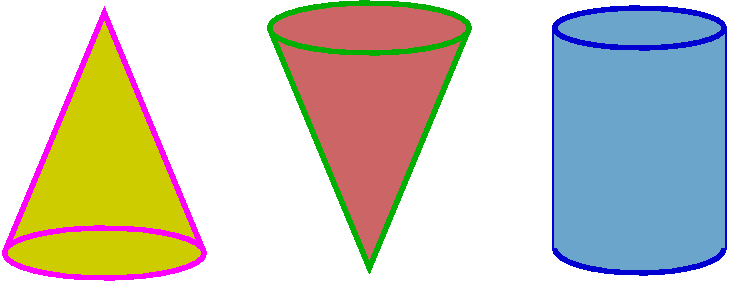 Intuition<-->Computation
Intuition<-->Computation
Definite integrals
These topics are covered in the first chapters of the text:
What to do? Some alternatives ...
So someone comes up to you on the street and says, "What's ![]() ab f(x)dx?" Here
if you're lucky the integrand, f(x), is some easily recognized
function. There are a bunch of algebraic tricks which may be helpful,
and we will begin to study them next time. But if this is the real
world, maybe all you need to know is some numerical approximation
to the value of the integral.
ab f(x)dx?" Here
if you're lucky the integrand, f(x), is some easily recognized
function. There are a bunch of algebraic tricks which may be helpful,
and we will begin to study them next time. But if this is the real
world, maybe all you need to know is some numerical approximation
to the value of the integral.
Numerical computation
Scientific and technical computation is present everywhere. The
algebraic tricks we'll see don't always work and sometimes all you can
do is get an approximate value. I mentioned in class that computer
processers and memories have been growing very quickly over the last
40 years, but that studies made of standard engineering problems
requiring lots of computation show that the speedups which have come
about result equally from faster processors and advances in the
computational algorithms. You should know something abou the
algorithms. Yeah, much of the time you will (as I do!) just
essentially "push a button" to get an approximate value. But some of
the time, perhaps when you least want to worry about it, your method
of choice may not work too well. So you should have some background
knowledge. That's what we will do today.
The very beginning ...
I'll show you three methods of approximating definite integrals. The
first is one you sort of know already, but I want to discuss it more
quantitatively. The second and third methods are quite practical, and
if you wanted to, you could actually compute fairly well with
them. Programming them is not too hard. I will admit, though, that
what I show you today is actually not what is used in, say, most
hand-held devices (such as graphing calculators). Somewhat more
elaborate (sophisticated?) methods are used there.
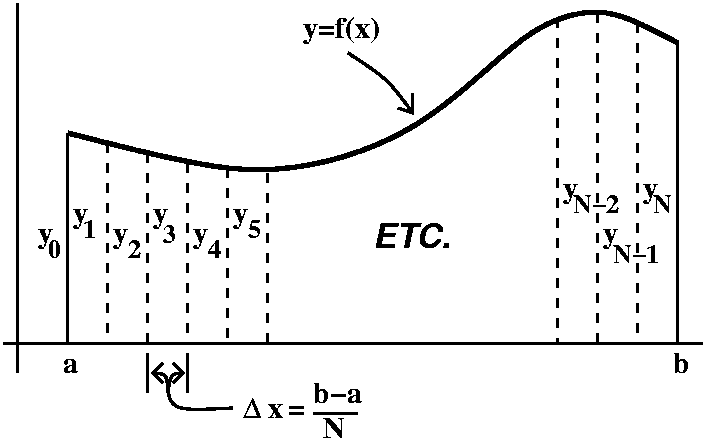
I'm going to try to use the notation in the text. So we'll investigate
the definite integral of f over the interval [a,b]. For all three
methods, we will chop up the interval into equal subintervals, say N
subintervals (you're supposed to think that N will be large). Since
the length of the whole interval is b-a, the length of each
subinterval will be (b-a)/N. We will call this
![]() x.
x.
There are N subintervals. The function, f(x), will have N+1 values at
all of the endpoints of all of the subintervals. (There's one more f
value then there are subintervals.) The function values will be
labeled y0, y1, y2, .... up to
yN. The y-value before the last one will be
yN-1. And, if you desperately wanted to know it,
y2, for example, is f(a+2![]() x)=f(a+2(b-a)/N).
x)=f(a+2(b-a)/N).
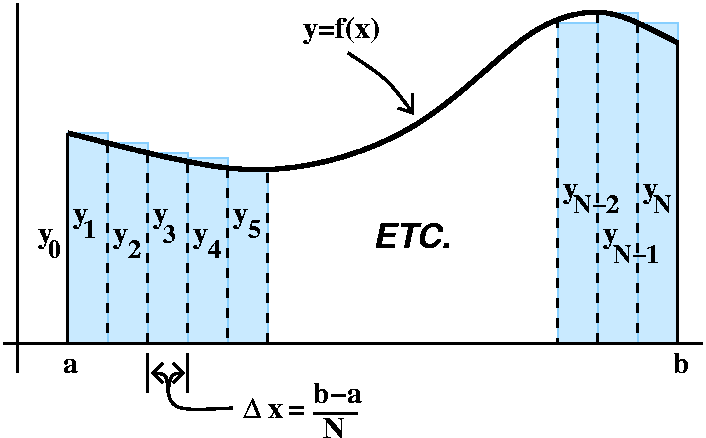 Level 0: Riemann sums, the definition
Level 0: Riemann sums, the definitionJust approximate each piece by a rectangle. This is just the Riemann sum, which appeared in the definition of definite integrals. The side that's used doesn't matter very much, but to be specific here I'll choose the left-hand endpoint and evaluate f there, and then multiply it by the length of the subinterval. |
Error estimate
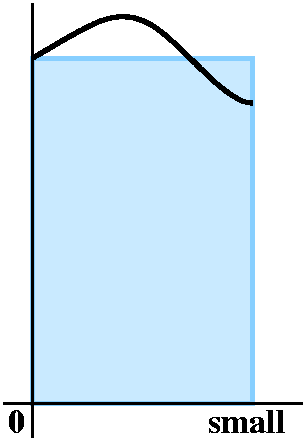 What turns out to be important in this business is,
first, how much work is the computation, and second, what sort of
error estimate is valid. Let me copy what I did in class. I looked at
an interval from 0 to small, so you should think of this as a very
narrow interval (yeah, but the picture ...).
What turns out to be important in this business is,
first, how much work is the computation, and second, what sort of
error estimate is valid. Let me copy what I did in class. I looked at
an interval from 0 to small, so you should think of this as a very
narrow interval (yeah, but the picture ...).
The true value of the integral is ![]() 0smallf(x)dx. The rectangle
approximating is has height f(0), the value on the left-hand endpoint,
multiplied by the width of the subinterval, small. This is
f(0)·small. But notice that this is also an integral:
0smallf(x)dx. The rectangle
approximating is has height f(0), the value on the left-hand endpoint,
multiplied by the width of the subinterval, small. This is
f(0)·small. But notice that this is also an integral: ![]() 0smallf(0)dx
(there is no x in this integrand!). So here is the error:
0smallf(0)dx
(there is no x in this integrand!). So here is the error:
![]() 0smallf(x)dx-
0smallf(x)dx-![]() 0smallf(0)dx
0smallf(0)dx
We are integrating over the same interval so this is the same as
![]() 0small(f(x)-f(0))dx.
0small(f(x)-f(0))dx.
The integrand is f(x)-f(0). One of the two results I said you
had to know from the first semester was MVT, the Mean Value
Theorem. I will use it here, and so f(x)-f(0)=f´(!!!)x. I don't much care (and I actually don't know much about) where !!! is. In fact, let me just assume that somehow I know some estimate for the largest value of the first derivative of f: I will call this, just as the textbook does, K1. Then
|![]() 0small(f(x)-f(0))dx|<=
0small(f(x)-f(0))dx|<=![]() 0smallK1x dx.
0smallK1x dx.
I can actually compute the integral of x, and the result is that the
error is at most K1[small2/2].
This is the error in one piece of the rectangular approximation. But there are N pieces, and we can't assume that the errors cancel: in general, they won't, and if you're using this for real, you'd better assume the worst. So we need to multiply by N, and the total error is at most N· K1[small2/2]. Things don't look too good, since N is large, but then several students observed that small is actually (b-a)/N so there are two N's "downstairs". One will cancel but this is the result.
Level 0
We approximate by (![]() x)y0+(
x)y0+(![]() x)y1+(
x)y1+(![]() x)y2+...+(
x)y2+...+(![]() x)yN-1 (we only go up to N-1, we don't use the last
height on f because this is the left-hand endpoint rectangles!). We
can factor, and the result is:
x)yN-1 (we only go up to N-1, we don't use the last
height on f because this is the left-hand endpoint rectangles!). We
can factor, and the result is:
Formula (![]() x)(y0+y1+y2+...+yN-1)
x)(y0+y1+y2+...+yN-1)
Error Less than K1(b-a)2/N where
K1 is some overestimate of |f´(x)| on all of [a,b].
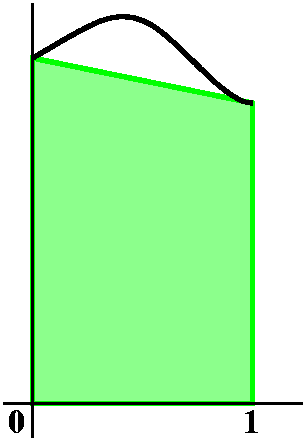 The next trick, straight lines
The next trick, straight lines
Let's put y=f(x) on the interval [0,1] so computations will be
easier. A likely better approximation would be to use a straight line,
maybe tilted, something like A+Bx. Here A and B will be selected so
that the values at 0 and 1 will agree with f(x). So the integral is
easy:
![]() 01A+Bx dx=Ax+(B/2)x2|01=A+B/2.
01A+Bx dx=Ax+(B/2)x2|01=A+B/2.
We know that f(0) should be A+Bx at 0, which is A, and f(1) should be
A+Bx at 1, which is A+B. In applications we'll be given f(0) and f(1),
and we will need to compute A+B/2. What should we do? Well, notice (?) that
Value at 0+value at 1=A+(A+B)=2A+B, and this is twice what we want, A+B/2.
Therefore we should just approximate the definite integral by
[f(0)+f(1)]/2. Another way to see this is just to notice that the
figure I've drawn is four-sided (a quadrilateral) with two of the
sides parallel: this is a trapezoid (which also names the method!) and
the formula comes from the formula for the area of a trapezoid.
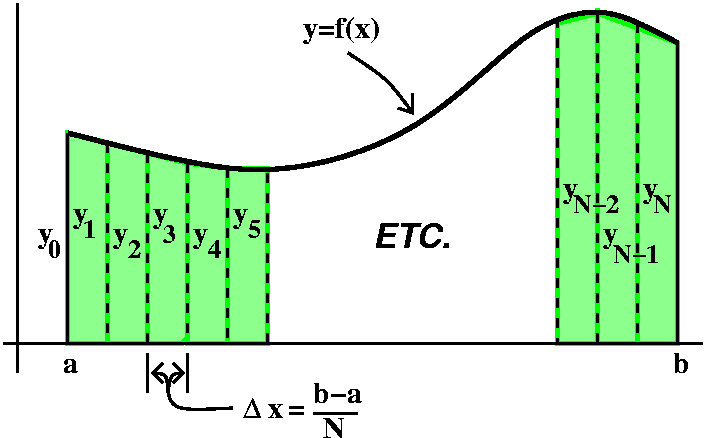 Putting it together
Putting it together
The picture attempts to illustrate what happens when a bunch of
trapezoids is used. Due to the scale of the picture and the thickness
of the lines, it is hard to see the error, but it is there. The error
is there because the graph is not made of line segments: it curves (in
fact, it curves, and somehow the amount the graph changes from being a
line is measured by the second derivative, which magically
appears below).
What does the trapezoid formula look like? Here:
[(![]() x)/2](y0+y1)+[(
x)/2](y0+y1)+[(![]() x)/2](y1+y2)+[(
x)/2](y1+y2)+[(![]() x)/2](y2+y3)+...+[(
x)/2](y2+y3)+...+[(![]() x)/2](yN-1+yN)
x)/2](yN-1+yN)
If you notice, this can be reorganized a bit.
Trapezoid Rule
Here is the reorganized formula, and an error estimate (getting this
error estimate is not as easy as the one before). The formula is
called the Trapezoid Rule.
Formula [(![]() x)/2](y0+2y1+2y2+...+2yN-1+yN)
x)/2](y0+2y1+2y2+...+2yN-1+yN)
Error Less than
K2(b-a)3/(12N2) where K2
is some overestimate of |f´´(x)| on all of [a,b].
Here what is important is the N2 on the bottom, since that gets larger much faster than N alone.
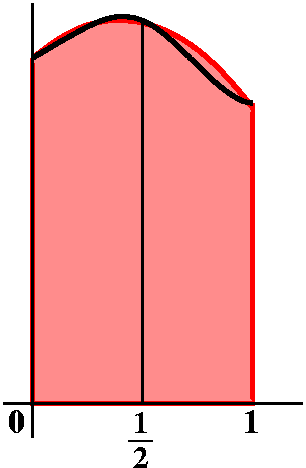 Ha: use three sample points, and parabolas!
Ha: use three sample points, and parabolas!
Back to y=f(x) on [0,1], and let's use A+Bx+Cx2 where A and B and C are selected so that at 0 and 1/2 and 1 the values will be f(0), f(1/2), and f(1). Because parabolas curve and maybe most functions have graphs that curve also, we might hope that the integral of the parabola is closer to the true value of the integral of the function. Now
![]() 01A+Bx+Cx2dx=Ax+(B/2)x2+(C/3)x3|01=A+B/2+C/3.
01A+Bx+Cx2dx=Ax+(B/2)x2+(C/3)x3|01=A+B/2+C/3.
Well, f(0) is A and f(1/2) is A+(B/2)+(C/4) and f(1) is A+B+C. Now one needs some inspiration in order to write A+B/2+C/3 in terms of those three quantities. Well, here is the inspiration. Suppose you take 4 times the value at 1/2: that's 4A+2B+C. Add on the values at 0 and at 1. The result is A+(4A+2B+C)+(A+B+C)=6A+3B+2C. (There are other ways of guessing, ways which are more systematic, and allow generalization, but I don't have time to show them to you: I am sorry.) Now 6A+3B+2C happens to be 6 times the integral, so we should divide f(0)+4f(1/2)+f(1) by 6. Sigh.
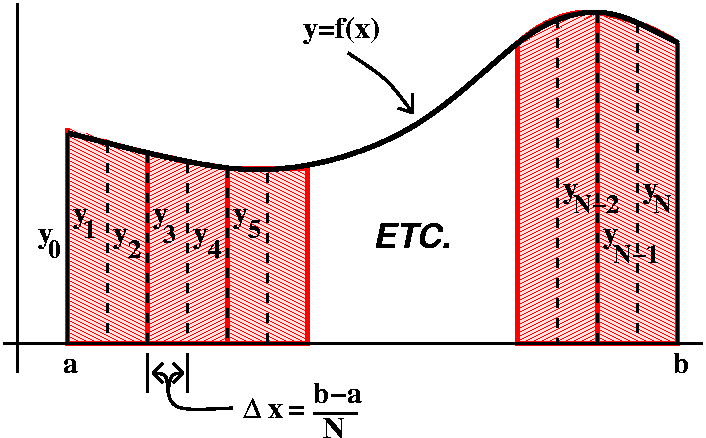 Simpson's Rule
Simpson's Rule
I want to lift the formula from the [0,1] case and use it in general.
Let's "transport" the parabola setup to the more general picture,
piecewise. So what do we need? First, we need to assume that N is
even. O.k.: fine. But the width of the subinterval is ![]() x, and this corresponds to ... what?
In the interval case, this corresponds to 1/2. So we should just
divide by 3 here. So this is what happens in the first few pairs of
intervals:
x, and this corresponds to ... what?
In the interval case, this corresponds to 1/2. So we should just
divide by 3 here. So this is what happens in the first few pairs of
intervals:
1y0+4y1+1y2 gets multiplied by (![]() x)/3.
x)/3.
1y2+4y3+1y4 gets multiplied by (![]() x)/3.
x)/3.
1y4+4y5+1y6 gets multiplied by (![]() x)/3.
x)/3.
· · ·
1yN-2+4yN-1+1yN gets multiplied by
(![]() x)/3.
x)/3.
If you observe the "structure" of the formula, you can see what happens. So this is Simpson's Rule:
Formula [(![]() x)/3](1y0+4y1+2y2+4y3+2y4+...2yN-2+4yN-1+1yN-1)
x)/3](1y0+4y1+2y2+4y3+2y4+...2yN-2+4yN-1+1yN-1)
Error Less than
K4(b-a)5/(180N4) where K4
is some overestimate of |f4(x)| on all of [a,b].
The implementation of Simpson's Rule is not much more work than the Trapezoid Rule of the "Rectangular Rule": just keep a running total of the odd and even heights inside the interval, multiply the odd final total by 4 and the even final total by 2, add on the end heights, and finish by multipling by a third of the interval length. Seriously, that's not too much work.
What happened to the error?
The fantastic thing is that the error is not some number divided by
the fourth power of N. That's unexpected. I have gone through a
direct proof of the error formula. It is not pleasant, but it can be
done (there are some very clever proofs -- I only went through an
"elementary" proof). What is amazing is that there's an
N4 and not a cubic power. Why? Well, accidentally
(more or less!) the Simpson's Rule formula is valid for x3:
we're just lucky. What do I mean? Well, ![]() 01x3dx=1/4, certainly (since
01x3dx=1/4, certainly (since
![]() x3dx=[x4/4]+C). And the idea was that we
should compute f(0)+4f(1/2)+f(1) divided by 6. Well, if
f(x)=x3, then f(0)=0, f(1/2)=1/8 and f(1)=1. So
f(0)+4f(1/2)+f(1)=0+4(1/8)+1=3/2. When we divide that by 6 we get
(3/2)/6=1/4: the correct answer! So we gain another power of accuracy,
and the error formula is even smaller.
x3dx=[x4/4]+C). And the idea was that we
should compute f(0)+4f(1/2)+f(1) divided by 6. Well, if
f(x)=x3, then f(0)=0, f(1/2)=1/8 and f(1)=1. So
f(0)+4f(1/2)+f(1)=0+4(1/8)+1=3/2. When we divide that by 6 we get
(3/2)/6=1/4: the correct answer! So we gain another power of accuracy,
and the error formula is even smaller.
Some numerical evidence
I computed (well, a machine did, at my direction!) approximations to
two examples and wrote the results on the board. One was ![]() 12[1/x]dx=ln(x)]12=ln(2)=ln(1)=ln(2)-0=ln(2),
which I "know". The other is
12[1/x]dx=ln(x)]12=ln(2)=ln(1)=ln(2)-0=ln(2),
which I "know". The other is ![]() 01[4/{1+x2}]dx=4 arctan(x)]01=4 arctan(1)-4 arctan(0)=4(Pi/4)-4(0)=Pi.Here are the results, with the three different rules and with a
varying number of pieces in the partition.
01[4/{1+x2}]dx=4 arctan(x)]01=4 arctan(1)-4 arctan(0)=4(Pi/4)-4(0)=Pi.Here are the results, with the three different rules and with a
varying number of pieces in the partition.
| n= | Left Hand Rule | Trapezoid Rule | Simpson's Rule |
|---|---|---|---|
| 10 100 1,000 10,000 100,000 |
0.7187714032 0.6956534302 0.6933972431 0.6931721811 0.6931496806 |
0.6937714035 0.6931534305 0.6931472430 0.6931471810 |
0.6931473748 0.6931471808 0.6931471803 |
| n= | Left Hand Rule | Trapezoid Rule | Simpson's Rule |
| 10 100 1,000 10,000 100,000 |
3.239925989 3.151575986 3.142592487 3.141692652 3.141602654 |
3.139925989 3.141575988 3.142592487 3.141592652 |
3.141592652 3.141592653 |
Things to think about
Although in theory any one of these computational schemes can give you
any accuracy desired, in practice there are other
considerations. First, you can worry about the amount of computational
time. Function evaluations take time on real machines. The lowest row
(n=100,000) took about half a minute. Second, numbers are represented
on real machines using floating point techniques, and arithmetic using
floating point numbers passes along and increases errors, so reducing
the number of divisions, multiplications, etc. is definitely a good
idea. For both of these reasons, and some others, the table should
convince you that the Trapezoid Rule and, especially, Simpson's Rule,
are worthwhile. They require almost the same amount of computation,
just a little more bookkeeping. But the n2 and especially
the n4 "downstairs" in the error estimates make these Rules
worthwhile.
QotD
| Time | Rate, in gal/hr |
|---|---|
| 1:00 | 50 |
| 2:00 | 70 |
| 3:00 | 35 |
| 4:00 | 60 |
| 5:00 | 40 |
If you've gotta have the numbers (?) I think they are 215 and 210 and 226.6666...
| Wednesday, January 30 | (Lecture #3) |
|---|
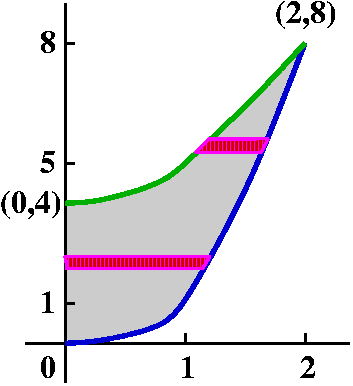 Now rotate around the y-axis
Now rotate around the y-axisWe can switch the roles of x and y, and try to do the problem using the method we had last time. So we will take the Sum of dy slices, from Bottom (y=0) to Top (y=8). Each slice will have approximate volume dy (the height) multiplied by the cross-sectional area. Now we have problems. What is the cross-sectional area?
When y goes from 0 to 4, the cross-sectional area is just the area of a circle. O.k., and the circle's radius is "x" when the point (x,y) is on the profile curve for the right boundary. The right boundary is given by y=x3, and since we are integrating with respect to y, the controlling variable is y, and we should write everything (such as x!) in terms of y. Well, if y=x3, then x=y1/3, and the cross-sectional area is Pi(y1/3)2=Piy2/3. But this is only valid for y's between 0 and 4.
When y is between 4 and 8, the cross-sectional area changes dramatically. It is an annular region, a region between two circles with the same centers. Looking at the picture, I hope that you can see there's an inner radius resulting from the curve y=x2+4, and an outer radius, coming from y=x3. Well, the thickness is still dy, and a little piece dV of the volume will be Pi(rout2-rin2)dy. We need to write the two r's in terms of y. And each of them is a horizontal measurement, so they are x's. Well, for rout we get y1/3 as in the previous paragraph. For rin we need to solve y=x2+4 for x. This is not too hard, so x2=y-4, and this seems to have two roots. But in this case the picture advises us that the x we want is certainly the positive root. So rin=sqrt(y-4). The cross-sectional area when y is between 4 and 8 is Pi((y1/3)2-(sqrt(y-4))2)= Pi(y2/3-(y-4)).
To compute the total volume we will need two definite integrals
because the formulas for the cross-sectional areas are given
piecewise. So here it is: ![]() 04Pi y2/3dy+
04Pi y2/3dy+![]() 48Pi(y2/3-(y-4))dy.
48Pi(y2/3-(y-4))dy.
Comments Certainly we can complete this computation. But I hope
that you can also see that generally there might be serious
difficulties with this approach. We might need to break the interval
of integration up in several pieces, and "solving" for x might be very
difficult.
|
Another way to find volumes We can find the volume when the region is rotated around the y-axis using a different technique, the method of thin shells. Chop the region up using vertical lines, and let's see what happens when we take a thin rectangle which is dx wide and rotate it around the y-axis. | 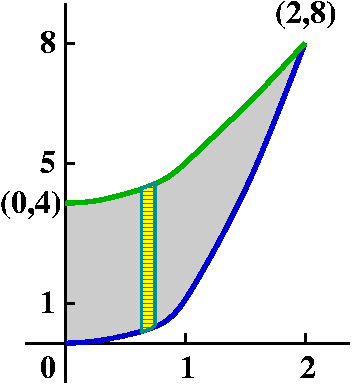
|
| I think what's created looks more like a thin ribbon, but this is classically called a thin shell, so that's what we should call it. The ribbon has a height and a radius and a very tiny thickness, dx. When its rotated around, the circumference of the circle produced is 2PiRadius. If we "cut" the shell and unroll it, we get approximately a rectangular solid which has measurements 2PiRadius and Height and dx. The volume should be, therefore, 2PiRadius·Height dx. | 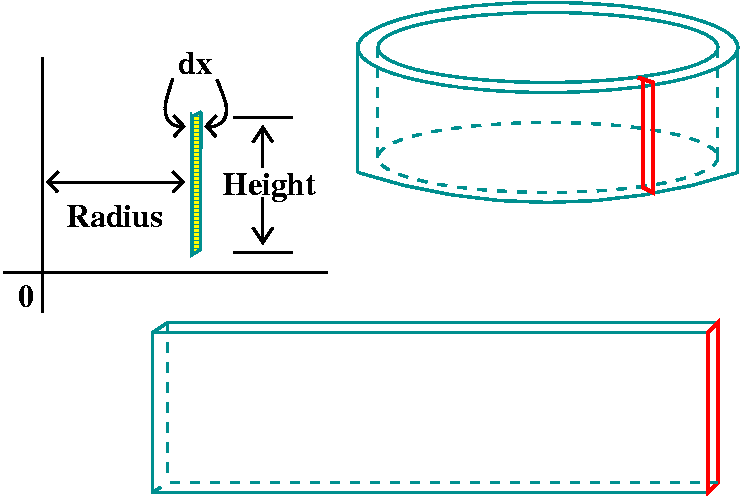
|
The computation
Thje controlling variable is x, and we need to write everything in
terms of x. Well, the Radius itself is just x (the distance to the
y-axis is x: this confuses me sometimes but maybe you see it
clearly). The Height is the difference between the top curve and the
bottom curve, so it is (x2+4-x3). We need to
add up (o.k., one last time: Sum) the
slices from left (x=0) to right (x=2). The result is
![]() 022Pi(x)(x2+4-x3)dx=2Pi
022Pi(x)(x2+4-x3)dx=2Pi![]() 02(x3+4x-x4)dx=2Pi([x4/4]+2x2-[x5/5]|02=2Pi(4+8-[32/5]).
02(x3+4x-x4)dx=2Pi([x4/4]+2x2-[x5/5]|02=2Pi(4+8-[32/5]).
You can check that the other method gives the same result (I
actually did, and it does).
Difficulties/opportunities
The more different ways you know to do a computation, the better off
you will be strategically. Some problems may yield to one method, and
be horribly recalcitrant with another. So please learn different
tricks.
Problem from the textbook
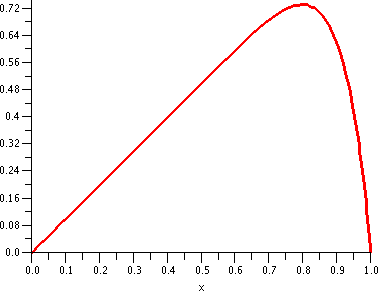 Here is problem 48 (must be very
difficult!) from section 6.4.
Here is problem 48 (must be very
difficult!) from section 6.4.
Use the Shell or Disk Method (whichever is easier) to compute the volume of the solid obtained by rotating the region shown (y=x-x12) about
(a) the x-axis (b) the y-axis.
Let's solve (a): we do it dx and get
![]() LeftRightPi(Radius)2dx=
LeftRightPi(Radius)2dx=![]() x=0x=1Pi(x-x12)2dx=Pi
x=0x=1Pi(x-x12)2dx=Pi![]() 01x2-2x13+x24dx=Pi([x3/3]-2[x14/14]+[x25/25])|01=Pi([1/3]-[2/14]+[1/25]).
01x2-2x13+x24dx=Pi([x3/3]-2[x14/14]+[x25/25])|01=Pi([1/3]-[2/14]+[1/25]).
Now for (b). If I wanted to do this dy, I would need to solve
y=x-x12 for x. I don't know a formula for this, and NO ONE
ELSE IN THE WORLD DOES. This would not be a feasible method. But dx
things are easy (thin shells). Here we go:
![]() LeftRight2Pi(Radius)(Height)dx=
LeftRight2Pi(Radius)(Height)dx=![]() 012Pi(x)(x-x12)dx=2Pi
012Pi(x)(x-x12)dx=2Pi![]() 01(x2-x13)dx=2Pi([x3/3]-[x14/14]|01=2pi([1/3]-[1/14]).
01(x2-x13)dx=2Pi([x3/3]-[x14/14]|01=2pi([1/3]-[1/14]).
 Hooke's Law
Hooke's Law
I began my discussion of work with a demonstration of Hooke's
Law, using specially obtained titanium (?) wire hangers and specially
obtained elasticium (?) bands. Maybe now I can take a $10,000 tax
deduction (doubtful). But I don't have time to write up the problems
in the order they were done.
I am desperately trying to catch up in writing this diary, so I am using some of the pictures and examples from last year. I am sorry. I will try to do better in the future. How can I get behind when we're only 10 days into the course? My apologies.
Work
which is physics which is something I know little about. I have been
told that Work=Force·Distance. Also I have been told that units
matter, and the most generally used units for Distance, Force, and
Work are meters, newtons, and joules. I will use as my units feet,
pounds, and foot-pounds. Sigh. So lifting 10 pounds for 5 feet does 50
foot-pounds of work. Huh. The only thing wrong is that the
abbreviation for pound is lb.
 Pulling a chain up a cliff
Pulling a chain up a cliff
I have an iron chain which weighs 3 pounds per foot and is 100 feet
long. It hangs from the edge of a tall cliff. How much work is
required to pull the chain to the top of the cliff?
Here's a picture of the chain. (Drawing the pictures is the fun part
for me.) We can imagine the chain's length being broken up into tiny
pieces, and then we would need to lift the pieces up the cliff. Let's
see: suppose we have a piece which is x feet from the top of the
cliff, and a tiny piece of length dx is imagined there. Then the
weight of that tiny piece is 3 dx (the 3 above is actually a sort
of linear density). To lift just that piece to the top of the cliff
needs x·3 dx amount of work. But the whole chain is made
up of these pieces, and so we need to add up this amount of work, and
(due to the way I set this up) we should take the integral from the
top (x=0) to the bottom (x=100) of the chain. This will get the total
work:
![]() 01003x dx=(3/2)x2|0100=(3/2)(100)2.
01003x dx=(3/2)x2|0100=(3/2)(100)2.
Springs
Many real world springs obey Hooke's Law over "a portion of their
elastic range". This means that the distortion of the spring from its
equilibrium length is in a direction opposite to the impressed force
and has length directly proportional to the force. This is, more or
less, "F=kx", where F is the force and x is the distortion from
equilibrium and k is a constant, frequently called the spring
constant. So twice the weight on a spring will distort it twice as
much, but you probably should not assume the same for, say, ten
thousand times as much weight. Here's a typical Hooke's law/work
problem.
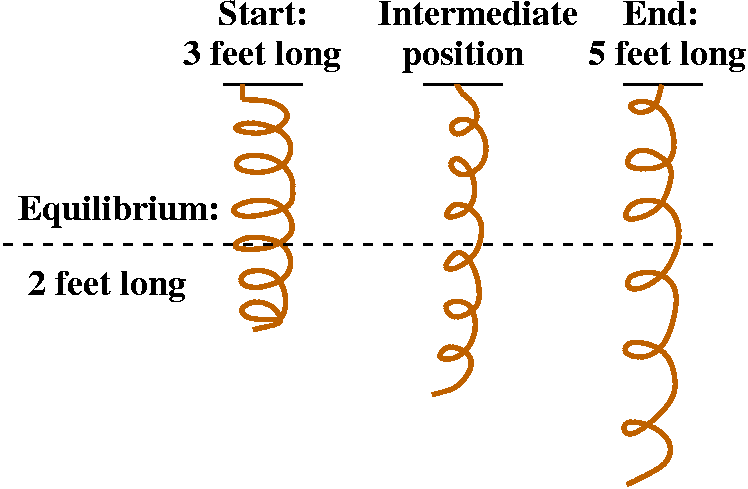 Pulling a spring
Pulling a spring
In equilibrium a spring is 2 feet long. A weight of 10 pounds
stretches it to 2.5 feet. How much work is needed to stretch the
spring from 3 feet long to 5 feet long?
Since 10 pounds changes the length of a spring by .5 feet, we know
that 10=k(.5) so that the spring constant, k, must be 20. Now consider
the various stages of the spring as it goes from the start position
(when the length is 3 and the distortion of 1) to the end position
(when the length is 5 and the distortion is 3). I'll call the
distortion, x. Perhaps we could consider an intermediate position. If
we pull the spring just a little bit more (change the length from x to
x+dx) we won't change the force very much. The force needed in that
intermediate position is 20x. The additional distance we're stretching
the spring is dx, so the "piece of work" we're doing is
20x dx. To get the total work we need to add up the pieces of
work from 3 feet long (when x=1) to 5 feet long (when x=3).
![]() 1320x dx=10x2|13=10(32)-10(12).
1320x dx=10x2|13=10(32)-10(12).
Caution When I do these problems, an
easy mistake to make is to confuse the spring length with the
distortion from equilibrium. Hooke's law applies to the distortion, so
that is what must be considered.
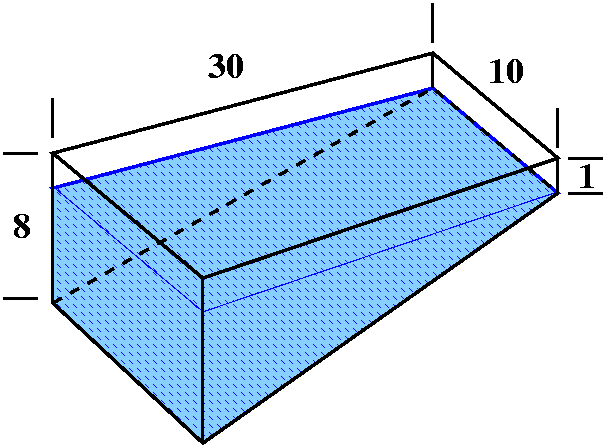 Emptying a pool
Emptying a pool
A pool has a rectangular top, 10 feet by 30 feet. The pool is 1 foot
deep at one of the edges which is 10 feet long, and is 8 feet deep at
the other edge which is 10 feet long. The depth varies linearly
between these edges. The pool is filled with water but the top of the
water level is 1 foot below the top of the pool. How much work is
needed to pump out the water in the pool (that is, to the top of the
pool?).
An oblique view of the pool is shown to the right. I hope that this picture corresponds to what your view of the description in words above. We need to raise the water to the top of the pool. To do this, we need some information about the force needed (the weight of the water).
The density of water is about 62.5 pounds per cubic foot. Generally, of course, stuff near the bottom compresses, but it turns out that water has rather low compressibility and we can accept the 62.5 as valid for all of the water in the pool.
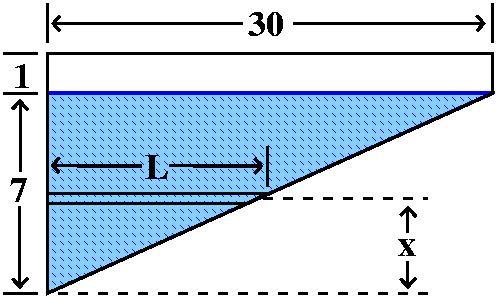 Although the lovely picture above pleases me (artistically!), a more
reasonable view might be sideways. I will put the origin of a
coordinate system for depth at the bottom of the pool (certainly there
may be one or two other reasonable places to put it). Then I will look
at a typical intermediate slice of the water volume at height x from
the bottom of the pool. The slice will have thickness dx. The reason
to look at this is that all of the water in that slice will need to be
lifted the same distance to the top of the pool. So this method of
organizing the computation allows me to put the distance into one part
of the problem, and then concentrate on the force (the weight of the
slice) in another part of the problem. But now we need to think about
the volume of the slice. It is dx thick, and I hope you can see that
the cross-section of the slice is a rectangle. It goes entirely across
the 10 foot width of the pool, and what varies in the slice is the
length, which I labeled L in the diagram. Similar triangles tell me
that L/x=30/7 so that L=(30/7)x. The volume of a slice is
(10)(30/7)x dx, so that the weight of a slice is
(62.5)(10)(30/7)x dx. This slice needs to be lifted to the top
of the pool (not just the top of the water!) and this distance is
1+(7-x)=8-x (I wrote it this way to emphasize that 7-x is the distance
to the top of the water, and 1 more foot to get to the top of the
pool). So the amount of work needed is (8-x)(62.5)(10)(30/7)x dx. To
get the total work I need to add up the work from the bottom of the
water (x=0) to the top of the water (x=7):
Although the lovely picture above pleases me (artistically!), a more
reasonable view might be sideways. I will put the origin of a
coordinate system for depth at the bottom of the pool (certainly there
may be one or two other reasonable places to put it). Then I will look
at a typical intermediate slice of the water volume at height x from
the bottom of the pool. The slice will have thickness dx. The reason
to look at this is that all of the water in that slice will need to be
lifted the same distance to the top of the pool. So this method of
organizing the computation allows me to put the distance into one part
of the problem, and then concentrate on the force (the weight of the
slice) in another part of the problem. But now we need to think about
the volume of the slice. It is dx thick, and I hope you can see that
the cross-section of the slice is a rectangle. It goes entirely across
the 10 foot width of the pool, and what varies in the slice is the
length, which I labeled L in the diagram. Similar triangles tell me
that L/x=30/7 so that L=(30/7)x. The volume of a slice is
(10)(30/7)x dx, so that the weight of a slice is
(62.5)(10)(30/7)x dx. This slice needs to be lifted to the top
of the pool (not just the top of the water!) and this distance is
1+(7-x)=8-x (I wrote it this way to emphasize that 7-x is the distance
to the top of the water, and 1 more foot to get to the top of the
pool). So the amount of work needed is (8-x)(62.5)(10)(30/7)x dx. To
get the total work I need to add up the work from the bottom of the
water (x=0) to the top of the water (x=7):
![]() 07(8-x)(62.5)(10)(30/7)x dx=(62.5)(10)(30/7)
07(8-x)(62.5)(10)(30/7)x dx=(62.5)(10)(30/7)![]() 078x-x2dx=(62.5)(10)(30/7)
(4x2-x3/3)|07=(62.5)(10)(30/7)(4(72)-73/3).
078x-x2dx=(62.5)(10)(30/7)
(4x2-x3/3)|07=(62.5)(10)(30/7)(4(72)-73/3).
Some comments on solutions of the work problems
The methods of solution are reasonable and the selection of problems
that I showed you was carefully structured.
| Monday, January 28 | (Lecture #2) |
|---|
As I mentioned, none of these have been shown to be as well-correlated
with success as this one: forming study groups with other students. Please form groups to study this
course. PLEASE!.
This page has been
created to help you.
Diary entry in progress!
The volume of a right circular cone
The volume of a sphere
The volume of a strange object
y=x2+4 and y=x3 and the y-axis.
Or an even stranger one
The volume of a torus
How to understand this result
| Wednesday, January 23 | (Lecture #1) |
|---|
What do you need to know?
Math 152 is the second semester of the three semester calculus
sequence which is given for students who really need to know
calculus (or who are pretty darn curious!). In many respects it is the
most technical, most computational of the three semesters. I
personally think it has many fewer big ideas and lots of computational
tricks. What do you need to know to begin this course appropriately?
| Function | Domain & range | Graph {in|de}creasing, concavity, asymptotics | Derivative | Integral (antiderivative) |
|---|---|---|---|---|
x2, x3, sqrt(x), x1/3, 1/x, etc. | YES!!! | |||
| exp(x)=ex | you | |||
| ln(x) | should | |||
| sin(x) | fill | |||
| cos(x) | in | box | ||
| tan(x) | every | |||
| arctan(x) | of | this chart | ||
| arcsin(x) | ||||
We also may sometimes need secant and even (sigh!) arcsec. Some poor engineering and physics majors may need to learn about the hyperbolic functions, so I will describe them later this semester.
What this course is about
Math 152 is quite technical. The principle excuse for the
technicality is that if you will have a career in science or
engineering, the methods of the course are part of the assumed
background of everyone. The course asks students to do some
hand computation which can be very elaborate. In most workplaces, this
computation will likely be strongly assisted by Maple or Mathematica or Matlab. (I use Maple myself but the others have similar
qualities.) The excuse for having students learn to compute by hand is
that they should then have some feeling for what strategies are useful
and for what the "shape" of the answers is like.
More precisely (about as precise as I can be at this stage) here is what the course is about:
Part 1: the uses of the definite integral
Definite integrals are used to compute lots and lots of quantities:
areas, volumes, masses, moments, pressures, ... hundreds of other
things you will learn about. A friend of mine wrote in a recently
published book that "This method of finding areas is paradigmatic for
an entire class of problems in which one is multiplying two quantities
such as
where the value of the first quantity can vary as the second quantity
increases." He is a great scholar, and uses words
precisely. The word "paradigm" means "an example or pattern." The
definite integral can be used to compute or approximate many
quantities (many more than are in the list just given). That's the
real power of calculus. Very few of you will compute many areas
professionally (or, actually, any areas professionally!). But I
am fairly sure that almost all of you will need to investigate and
compute many definite integrals. So initially we will consider some
simple uses of definite integrals.
Part 2: computing definite integrals
Once you have the creature (a definite integral), what is it?
38.5? Pi/sqrt(2)? We need some methods.
That's the plan of the course. There are a few minor additional topics, but please take a look at the syllabus. It will give you a good idea of where we are headed.
How do we teach it?
There are two lectures each week. The lecturer is correct 72.6% of the
time, and needs students to point out the almost inevitable
exxors. The diary may help. There is an additional meeting each
week. Most of those meetings will have most of their time devoted to
workshops. Small groups of students will investigate calculus
problems. One of these problems will later be designated for a writeup. Attendance will be taken
at every meeting of the course, and quizzes may or may not be given
without further announcement.
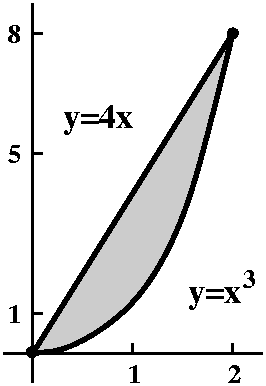
Let's begin
We will compute the area in the plane enclosed by y=x3 and
the line segment which joins (0,0) and (2,8). The region is shown to
the right. The points (0,0) and (2,8) are on y=x3, and the
region is bounded by the line y=4x and the cubic curve. (This is not
supposed to be difficult to see!).
First method
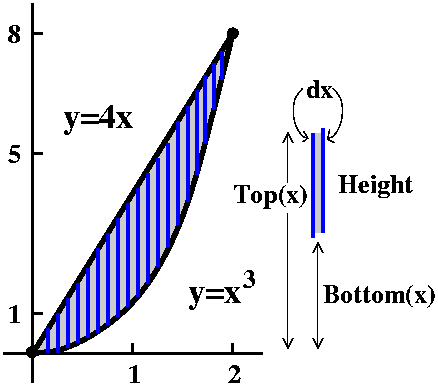 We slice the area by lines parallel to the y-axis. I think of the
lines as dx apart. The region is chopped up into things which
are almost rectangles, and the area of each piece is going to
be HEIGHT·dx. We will get a good approximation to the total
area by taking the Sum of the areas of
these almost rectangular pieces. Of course what I mean by "Sum" is a definite integral, because that includes
a limiting process which makes increases the accuracy of the
approximations. So in this setup, we will have
We slice the area by lines parallel to the y-axis. I think of the
lines as dx apart. The region is chopped up into things which
are almost rectangles, and the area of each piece is going to
be HEIGHT·dx. We will get a good approximation to the total
area by taking the Sum of the areas of
these almost rectangular pieces. Of course what I mean by "Sum" is a definite integral, because that includes
a limiting process which makes increases the accuracy of the
approximations. So in this setup, we will have ![]() LeftRightHeight dx. We add up the
slices from the left to the right of the region. Here we have slices
which are dx thick, and we should try to write everything in terms of
x. Let's see: the Left and Right are easy enough, because the
left-most point of the region occurs when x=0, and the right-most
point of the region occurs when x=2. What about the height of the
rectangularish (that's a word?) slice? Well, the height will be the
difference between the top measurement, that is, the curve which forms
the boundary of the region with larger y values, and the bottom, the
curve which forms the boundary of the region with lower y values. This
is a rather simple region, and it isn't too difficult (I hope!) to see
that Top(x)=4x and Bottom(x)=x3. In more complicated cases,
the curves can cross, and to compute the area we may need to break up
the definite integral so cancellation doesn't occur (if you don't know
what I mean, please reread section 6.1, and learn again that
the definite integral computes the net signed area). Please remember
also that the Height will always be gifven by Top(x)-Bottom(x): this
formula is valid no matter what the signs of the functions are, as long
as Top(x) is geometrically higher than Bottom(x) (well, of
course, since then Top(x)>Bottom(x)).
LeftRightHeight dx. We add up the
slices from the left to the right of the region. Here we have slices
which are dx thick, and we should try to write everything in terms of
x. Let's see: the Left and Right are easy enough, because the
left-most point of the region occurs when x=0, and the right-most
point of the region occurs when x=2. What about the height of the
rectangularish (that's a word?) slice? Well, the height will be the
difference between the top measurement, that is, the curve which forms
the boundary of the region with larger y values, and the bottom, the
curve which forms the boundary of the region with lower y values. This
is a rather simple region, and it isn't too difficult (I hope!) to see
that Top(x)=4x and Bottom(x)=x3. In more complicated cases,
the curves can cross, and to compute the area we may need to break up
the definite integral so cancellation doesn't occur (if you don't know
what I mean, please reread section 6.1, and learn again that
the definite integral computes the net signed area). Please remember
also that the Height will always be gifven by Top(x)-Bottom(x): this
formula is valid no matter what the signs of the functions are, as long
as Top(x) is geometrically higher than Bottom(x) (well, of
course, since then Top(x)>Bottom(x)).
O.k., now we have ![]() x=0x=2(4x-x3)dx. This definite integral is sufficiently simple that it can be computed directly using FTC. We "guess" an antiderivative, and here's the computation:
x=0x=2(4x-x3)dx. This definite integral is sufficiently simple that it can be computed directly using FTC. We "guess" an antiderivative, and here's the computation:
![]() 02(4x-x3)dx=2x2-x4/4|02=(2(22)-24/4)-0=8-4=4.
02(4x-x3)dx=2x2-x4/4|02=(2(22)-24/4)-0=8-4=4.
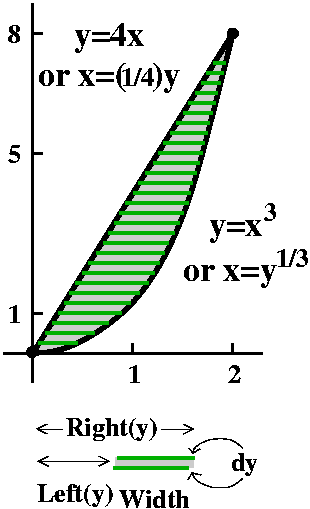
And again
Let's compute the area of the region in the plane enclosed by
y=x3 and the line segment which joints (0,0) and
(2,8). Huh? Yeah, well, I want to do it again,
but I want to do it a different way. The more techniques you have
available, the more likely you will be able to analyze a model
successfully or complete a computation, even if your favorite method
fails. In this case, I want to "dissect" or take apart the region dy.
Draw many horizontal lines in the region, and space the
horizontal lines dy apart. The region is broken up into pieces, each
of which is sort of a rectangle. The rectangle has some Width and a
height of dy, so its area is just about Width·dy. Again we will
Sum these strips, now from the bottom (the
smallest value of y) to the top, the largest value of y. So the area
of the region is ![]() BottomTopWidth dy. To carry out the
computation, we need to write everything in terms of y. Well, the
bottom value of y is 0 and the top value of y is 8. That's easy. What
about the width? Each strip has a right and left border, and the
distance of these borders to the y-axis varies with y. So we need
these distances, which I called in the accompanying diagram Left(y)
and Right(y). For example, the Left(y) border corresponds to the line
segment, which has equation y=4x. Here x is the distance to the
y-axis, so we need x in terms of y. This is a toy
problem! We take y=4x and solve for x to get
x=(1/4)y. Similarly, for Right(y), the equation y=x3
becomes x=y1/3, and Right(y)=y1/3. Now let's
compute the area again.
BottomTopWidth dy. To carry out the
computation, we need to write everything in terms of y. Well, the
bottom value of y is 0 and the top value of y is 8. That's easy. What
about the width? Each strip has a right and left border, and the
distance of these borders to the y-axis varies with y. So we need
these distances, which I called in the accompanying diagram Left(y)
and Right(y). For example, the Left(y) border corresponds to the line
segment, which has equation y=4x. Here x is the distance to the
y-axis, so we need x in terms of y. This is a toy
problem! We take y=4x and solve for x to get
x=(1/4)y. Similarly, for Right(y), the equation y=x3
becomes x=y1/3, and Right(y)=y1/3. Now let's
compute the area again.
![]() y=0y=8(y1/3-(1/4)y)dy=(3/4)y4/3-(1/8)y2|08=((3/4)84/3-(1/8)82)-(0)=(3/4)24-8=12-8=4.
y=0y=8(y1/3-(1/4)y)dy=(3/4)y4/3-(1/8)y2|08=((3/4)84/3-(1/8)82)-(0)=(3/4)24-8=12-8=4.
Comments
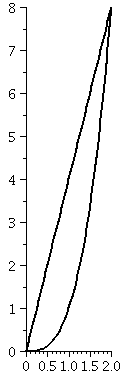 I'm really happy that the two results were the same. As I mentioned in
class, the second computation took me three tries in "rehearsal"
before I got the answers to coincide. Embarrassment is a great
motivator. It turns out (as you will see in Math 251) that these dual
computations are really quite interesting. We got 12-8=4 and
8-4=4. Some much more complicated computations are really similar.
I'm really happy that the two results were the same. As I mentioned in
class, the second computation took me three tries in "rehearsal"
before I got the answers to coincide. Embarrassment is a great
motivator. It turns out (as you will see in Math 251) that these dual
computations are really quite interesting. We got 12-8=4 and
8-4=4. Some much more complicated computations are really similar.
Yes, these is a toy computation. Let's see: I'll work with toys because I have limited time in class. I'll work with toys because the computational details would otherwise obscure the ideas. I'll work with toys, well, because I can do them. In order to finish the second computation, I needed to find the inverses of the functions x-->4x and x-->x3. I can do this. Many other functions do not have inverses which are easy to compute. I hope you recognize this problem.
The pictures I have been drawing are "stylized". That is, I tried to draw what I thought were the essential features (straight and curved lines where they should be straight and curved, for example). But I neglected some proportions. People who use computers and calculators sometimes are not sensitive to this feature, which even in this case leads to some distortion. To the right is a picture with true proportions. You can compare it to what been shown in the other illustrations.
Now a volume
Suppose a solid object has as its base the region we've been
describing: enclosed by y=x3 and the line segment which
joints (0,0) and (2,8). Suppose the cross-sections or slices of the
solid by planes perpendicular to the xy-plane and parallel to the
x-axis are isoceles right triangles, with one leg of the triangle in
the xy-plane. Sketch this solid, and compute its volume.
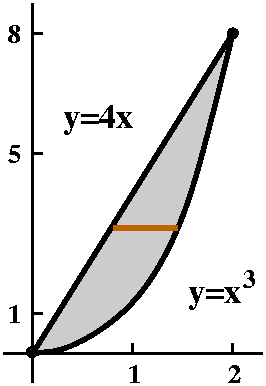 If you are new to this subject, there is much information "encoded" in
the parabraph above. I hope you know the base, the bottom of the
solid. It is a flat region in the plane. The solid itself is above
this region. The important sentence in the paragraph is
If you are new to this subject, there is much information "encoded" in
the parabraph above. I hope you know the base, the bottom of the
solid. It is a flat region in the plane. The solid itself is above
this region. The important sentence in the paragraph is
Suppose the cross-sections or slices of the solid by planes perpendicular to the xy-plane and parallel to the x-axis are isoceles right triangles, with one leg of the triangle in the xy-plane.This is rather compact and technical language. First, let's consider the slices. Each slice is an isoceles right triangle. An isoceles triangle has two sides which are the same length.
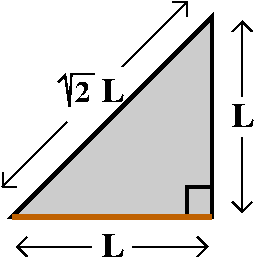 Since in a
right triangle, the hypotenuse is longer than either of the legs, the
only way a right triangle can be isoceles is when the legs have the
same length. And that will occur when both of the acute angles equal
45o or Pi/4 radians. I think that an isoceles right
triangle looks like what is shown to the right. If the base or bottom
side of the triangle (a leg!) has length L, then the height, another
leg, will also have length L, and the hypotenuse will have length
sqrt(2)L. The area of this triangle will be (1/2)L2.
Since in a
right triangle, the hypotenuse is longer than either of the legs, the
only way a right triangle can be isoceles is when the legs have the
same length. And that will occur when both of the acute angles equal
45o or Pi/4 radians. I think that an isoceles right
triangle looks like what is shown to the right. If the base or bottom
side of the triangle (a leg!) has length L, then the height, another
leg, will also have length L, and the hypotenuse will have length
sqrt(2)L. The area of this triangle will be (1/2)L2.
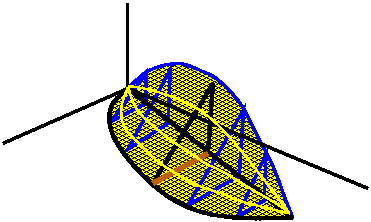 What can the solid object look like? Here I'll just make an
attempt. If you are new to this stuff, your attempts may not be
terrific the first few times, but they will improve if you practice. I think my version of the
solid looks like what is shown to the right. It has a flat bottom and
a flat side, and the third side is curved, but is made up of lots of
hypotenuses (is that the plural? I also worry about hippopotamuses, or
musi ...). Of course, such solids can't exist in real life, and, for
example, engineers therefore should not worry about them. NOT
CORRECT!!! Even if your first attempt at drawing the
solid is not agreeable, I hope that you would eventually feel you
could build one by carving it out of wood or shaping clay.
What can the solid object look like? Here I'll just make an
attempt. If you are new to this stuff, your attempts may not be
terrific the first few times, but they will improve if you practice. I think my version of the
solid looks like what is shown to the right. It has a flat bottom and
a flat side, and the third side is curved, but is made up of lots of
hypotenuses (is that the plural? I also worry about hippopotamuses, or
musi ...). Of course, such solids can't exist in real life, and, for
example, engineers therefore should not worry about them. NOT
CORRECT!!! Even if your first attempt at drawing the
solid is not agreeable, I hope that you would eventually feel you
could build one by carving it out of wood or shaping clay.
Another word ...
I don't think in the previous discussion that I emphasized enough that
the cross-sections were to be perpendicular to the
base. There are lots of ways to slice solids, and then to describe the
solids. I could take a loaf of bread and slice it perpendicular to the
base, the bottom of the loaf. Or I could be more artistic (?) and
slice it in some way that was angled to the base ("obliquely"). Below
is an attempt to show you what I mean. We are analyzing a solid which
is similar to the left-hand loaf of bread, where the slices are
perpendicular to the base.
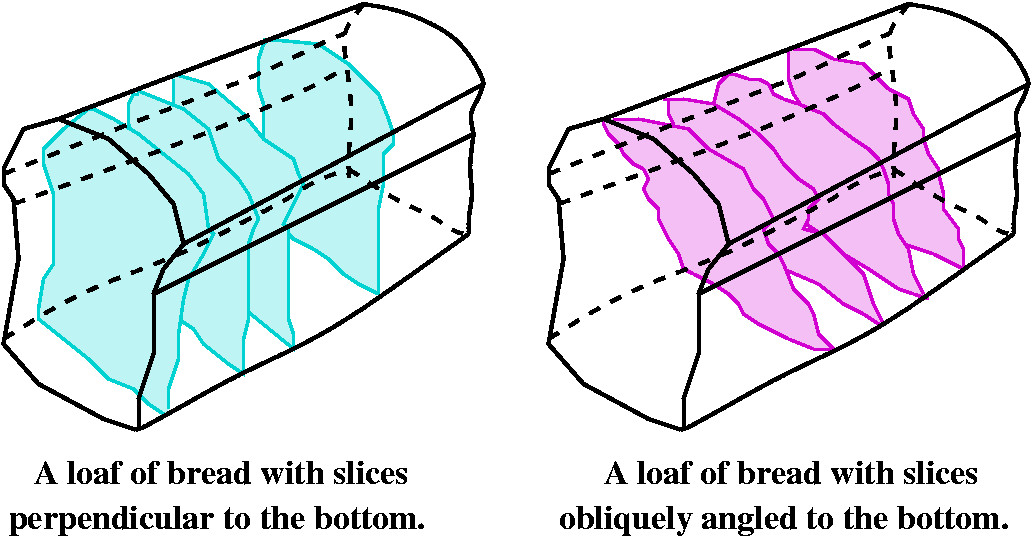
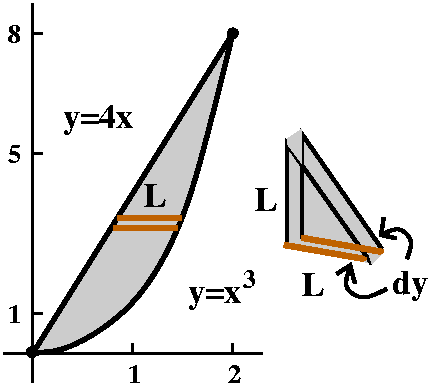 How to compute the volume
How to compute the volume
We could get the total amount of bread by adding up the bread in all
the slices. Similarly, we will get the total volume of our solid by
imagining that it is dissected by numerous appropriate slices. To take
advantage of the description, the slices will be parallel to the
x-axis and perpendicular to the xy-plane. We also will think that the
slices are about dy thick. Each individual slice is almost a nice
solid, dy thick, with sides that are almost equal, having an area of
(1/2)L2 where L is the indicated length in the figure. So
dV, a piece of the volume, will be about (1/2)L2dy. And the
total volume is obtained by adding up the pieces of volume, V=![]() dV.
dV.
Let's be more precise. We will integrate with respect to y. The limits
of integration will be as in the second computation of volume: y=0 to
y=8. The length labeled L here is exactly what I called Width there,
so L=Width=Right(y)-Left(y)=y1/3-(1/4)y, and we need to
compute ![]() y=0y=8(1/2)(y1/3-(1/4)y)2dy. We can "pull out" the (1/2) but the
best thing to do to the rest is "expand" it (multiply out). Here we
go:
y=0y=8(1/2)(y1/3-(1/4)y)2dy. We can "pull out" the (1/2) but the
best thing to do to the rest is "expand" it (multiply out). Here we
go:
![]() y=0y=8(1/2)(y1/3-(1/4)y)2dy=(1/2)
y=0y=8(1/2)(y1/3-(1/4)y)2dy=(1/2)![]() y=0y=8y2/3-(2/4)y4/3+(1/[16])y2 dy=(1/2)((3/5)y5/3-(3/[14])y7/3+(1/[48])y3(1/2))|08=([128]/[105]) clearly
y=0y=8y2/3-(2/4)y4/3+(1/[16])y2 dy=(1/2)((3/5)y5/3-(3/[14])y7/3+(1/[48])y3(1/2))|08=([128]/[105]) clearly
No, not clearly!!!. In fact, if you had to do this on an exam or for homework, please report the answer as (1/2)((3/5)85/3-(3/[14])87/3+(1/[48])83(1/2)). That's a very very good way to report the answer. I got the number given because a friend told me.
> int((1/2)*(y^(1/3)-(1/4)*y)^2,y=0..8);
128
---
105
And another volume Hew of course we will slice the solid dx. The cross-sectional area is
the area of half of a circle whose diameter is L. Well, the area of a
whole circle with radius Pi is Pi·r2. Here r is
(1/2)L, so that the cross-sectional area is
(1/2)Pi[(1/2)L]2. Repeating: the first 1/2 is because we
have half of the area of a circle, and the second 1/2, inside the
parentheses, is because we are changing diameter into radius. Here the
setup is dx. The limits of integration look back to the first
computation of the area, so that x=0 is the lower limit and x=2 is the
upper limit. L is what I called Height then, so
L=4x-x3. What is the volume of the solid? Here we
go. Notice that the (Pi/8) factor comes from Pi(1/2)(1/2)2
pulled out of the integral (we can do that with multiplicative
factors!).
Hew of course we will slice the solid dx. The cross-sectional area is
the area of half of a circle whose diameter is L. Well, the area of a
whole circle with radius Pi is Pi·r2. Here r is
(1/2)L, so that the cross-sectional area is
(1/2)Pi[(1/2)L]2. Repeating: the first 1/2 is because we
have half of the area of a circle, and the second 1/2, inside the
parentheses, is because we are changing diameter into radius. Here the
setup is dx. The limits of integration look back to the first
computation of the area, so that x=0 is the lower limit and x=2 is the
upper limit. L is what I called Height then, so
L=4x-x3. What is the volume of the solid? Here we
go. Notice that the (Pi/8) factor comes from Pi(1/2)(1/2)2
pulled out of the integral (we can do that with multiplicative
factors!).
QotD
I'll try to give a simple computation, usually towards the end of each
lecture, which I call the Question of the Day. Students get full
credit for handing in any answer. (Yeah, a way to take
attendance.) This is also a way for me to see if people understand
what I am doing. This is also a way for students, if they wish, to see
if they can do (correctly!) what the lecturer considers to be a
"simple computation". Here the QotD was the computation of the
integral above.
Maintained by greenfie@math.rutgers.edu and last modified 1/24/2008.